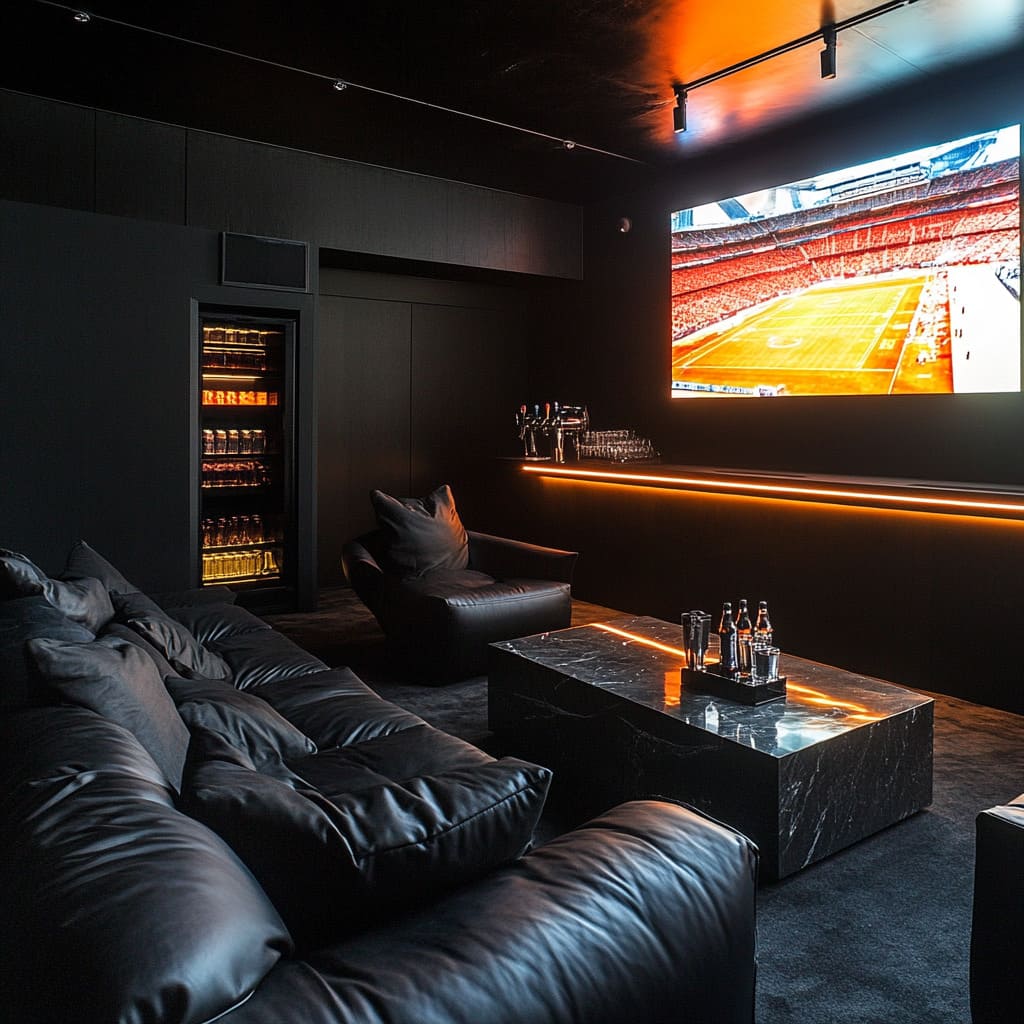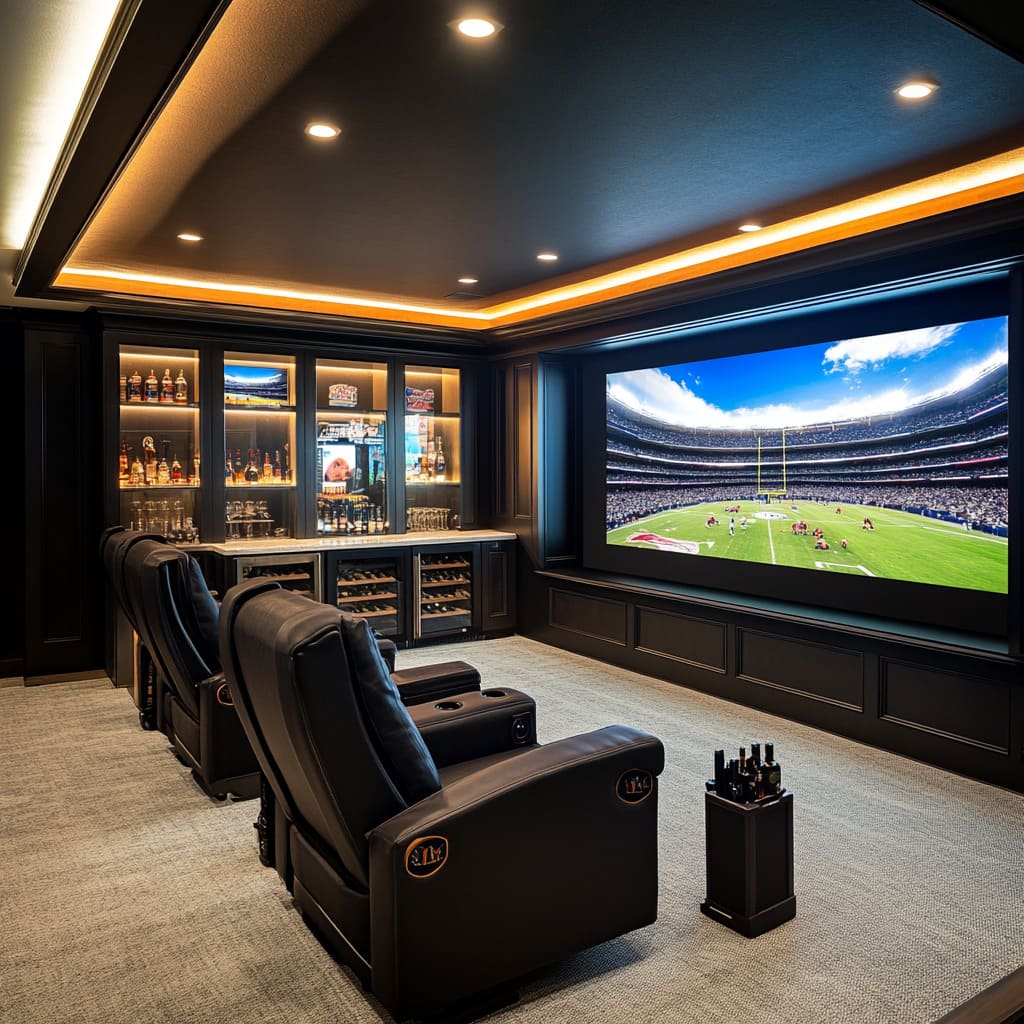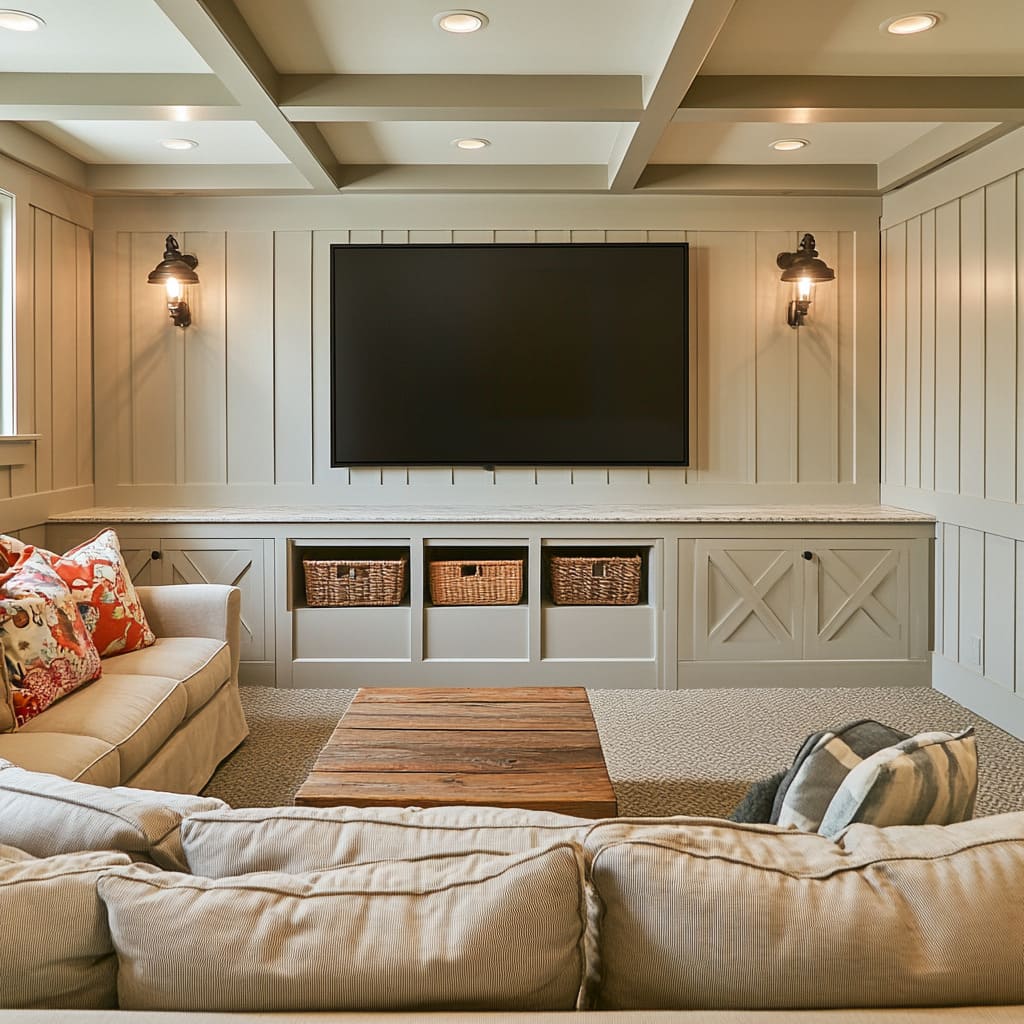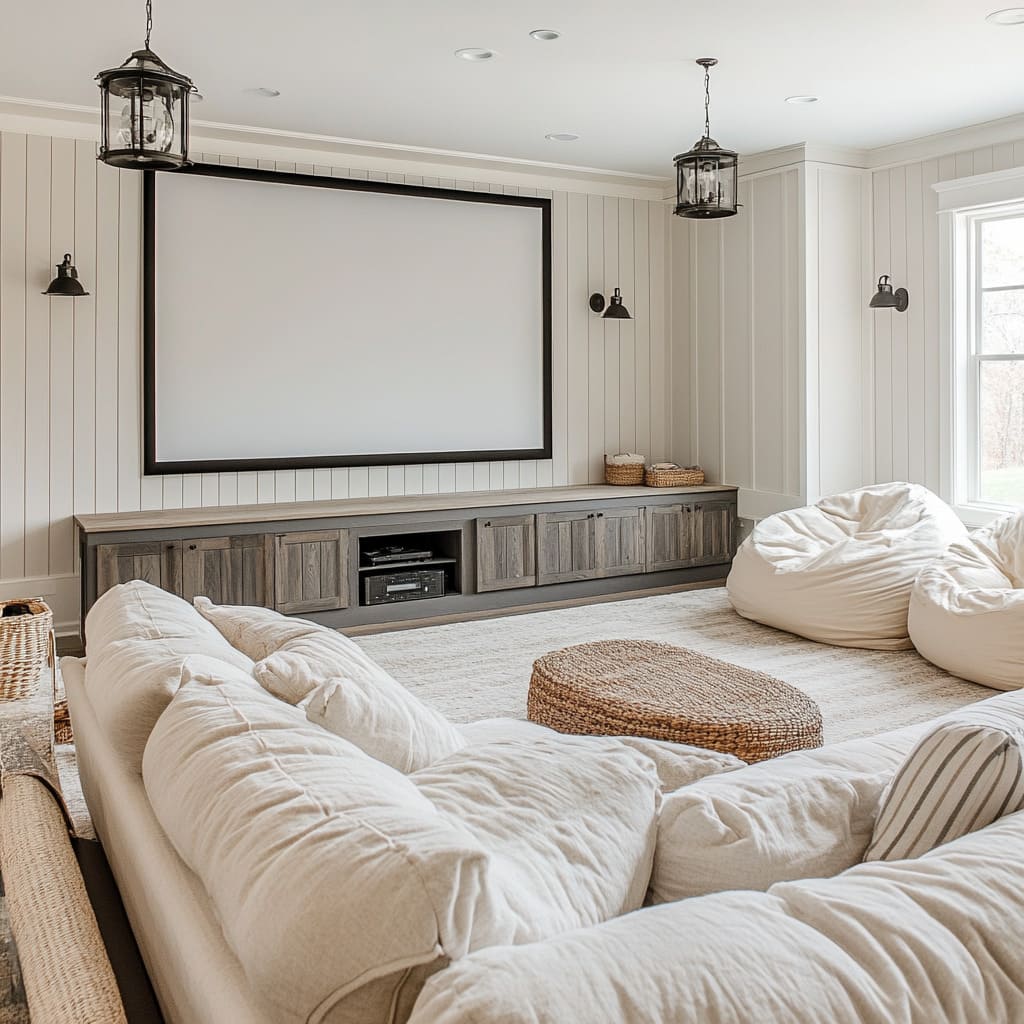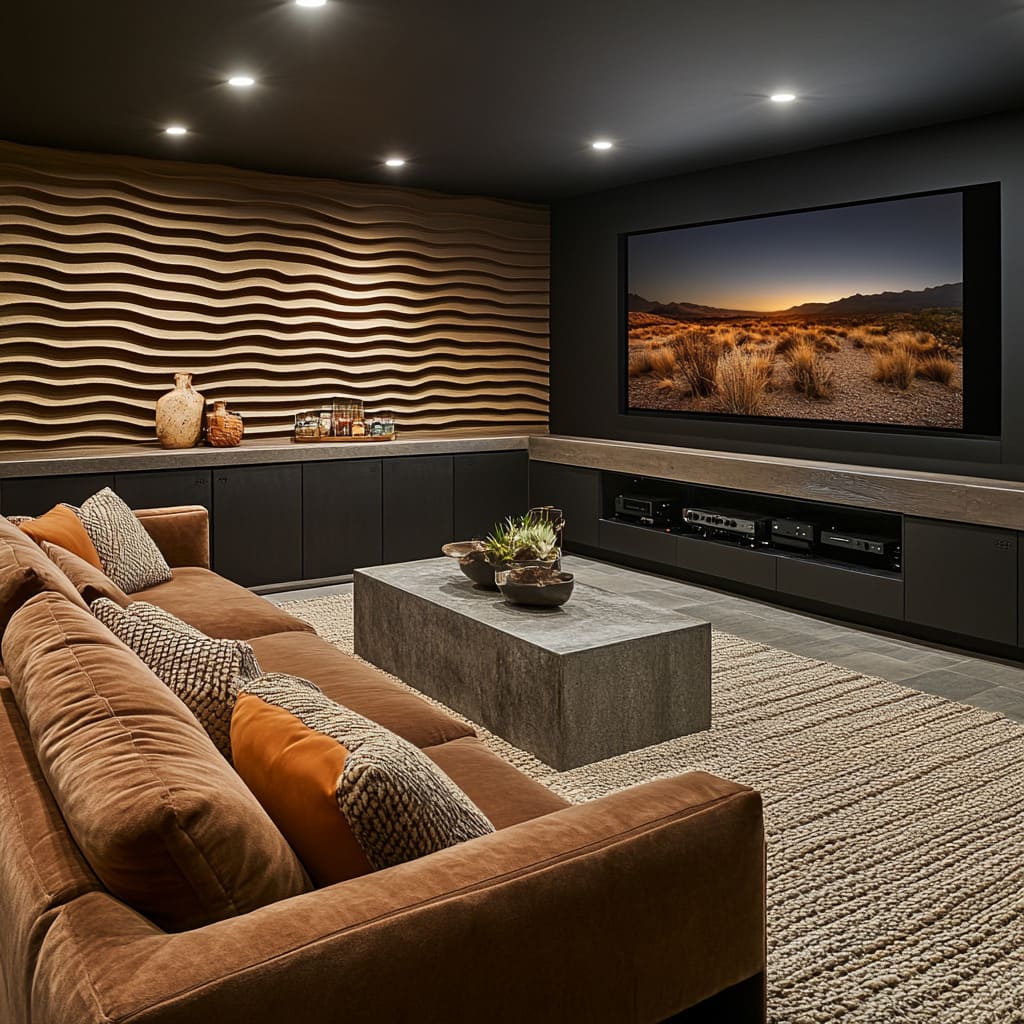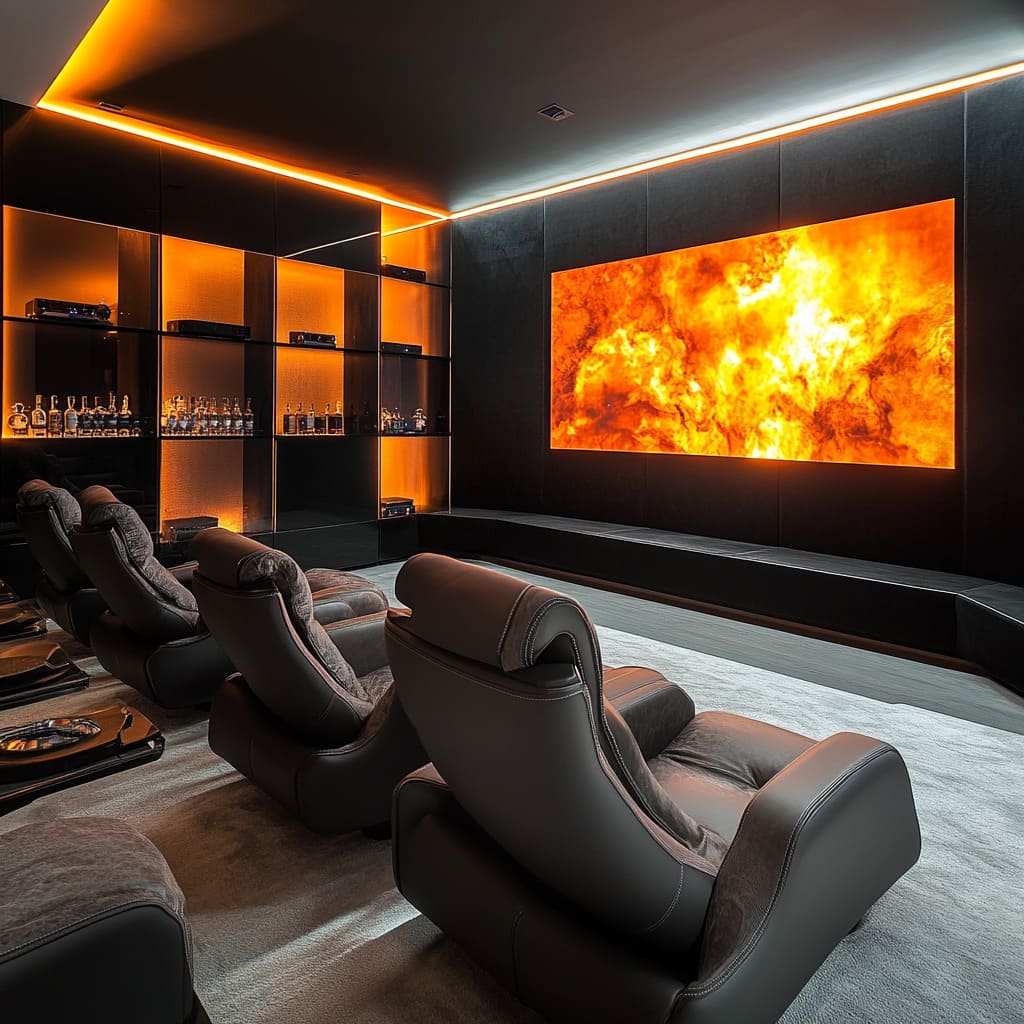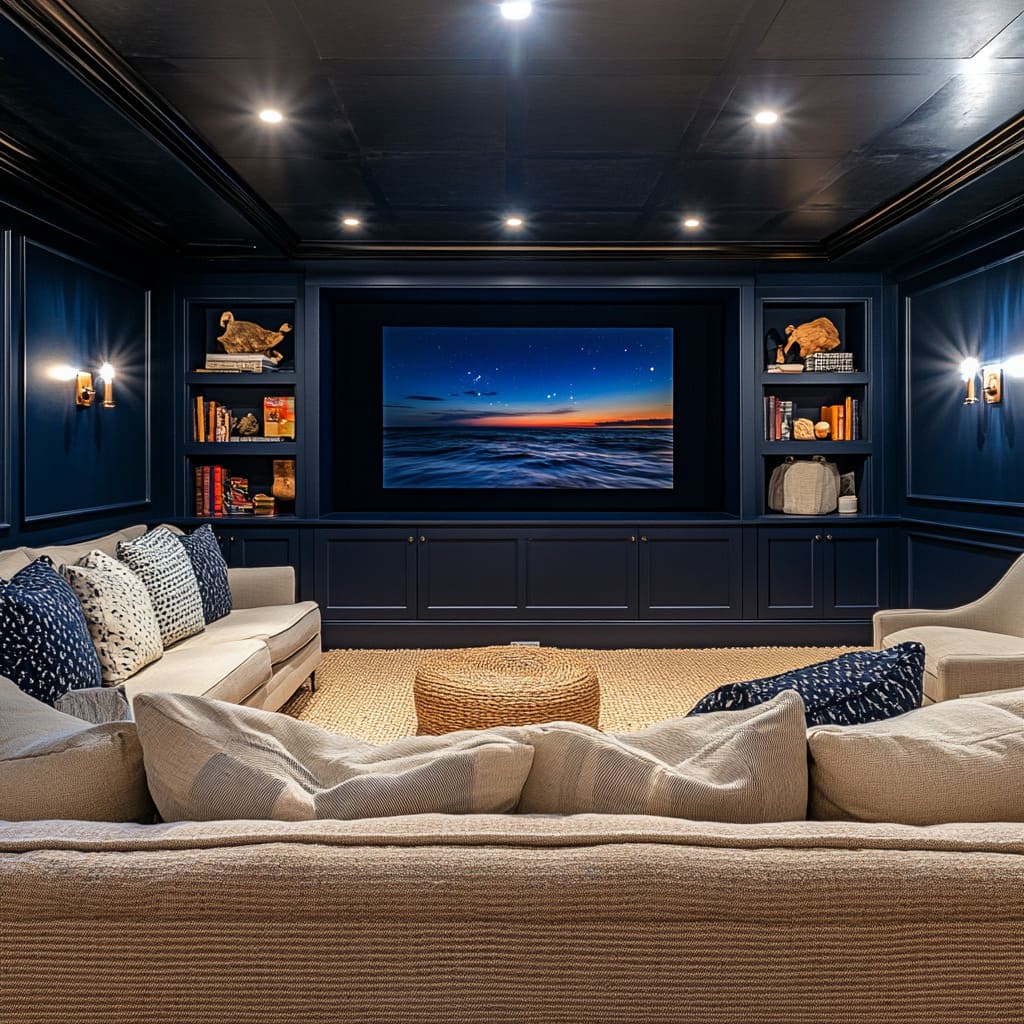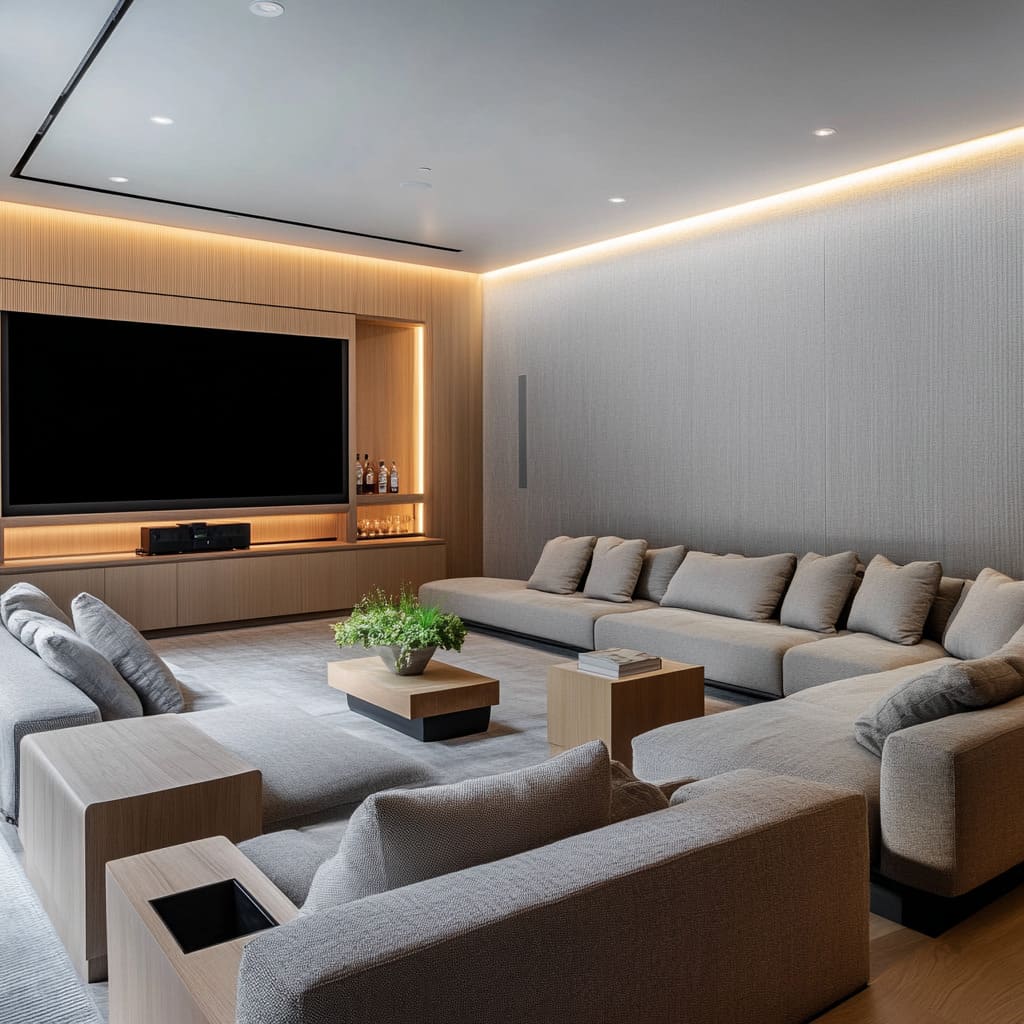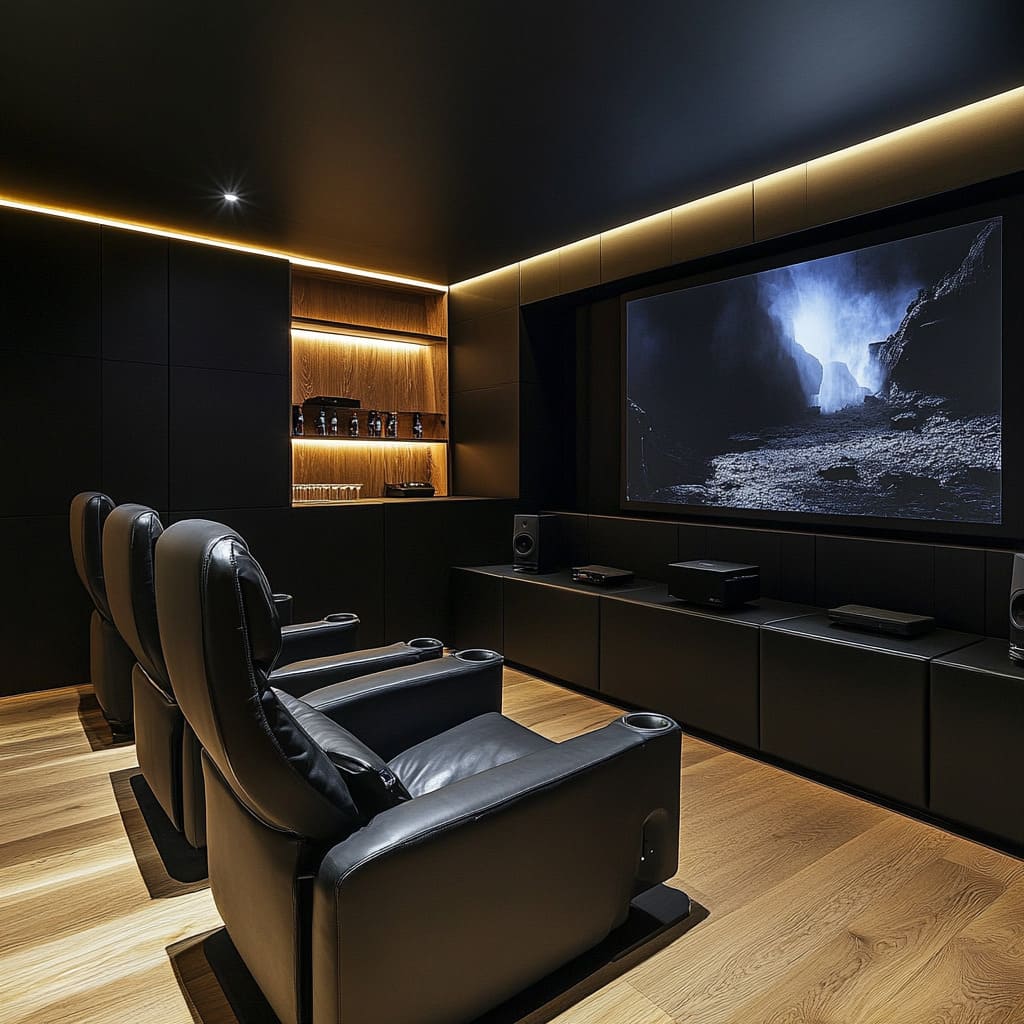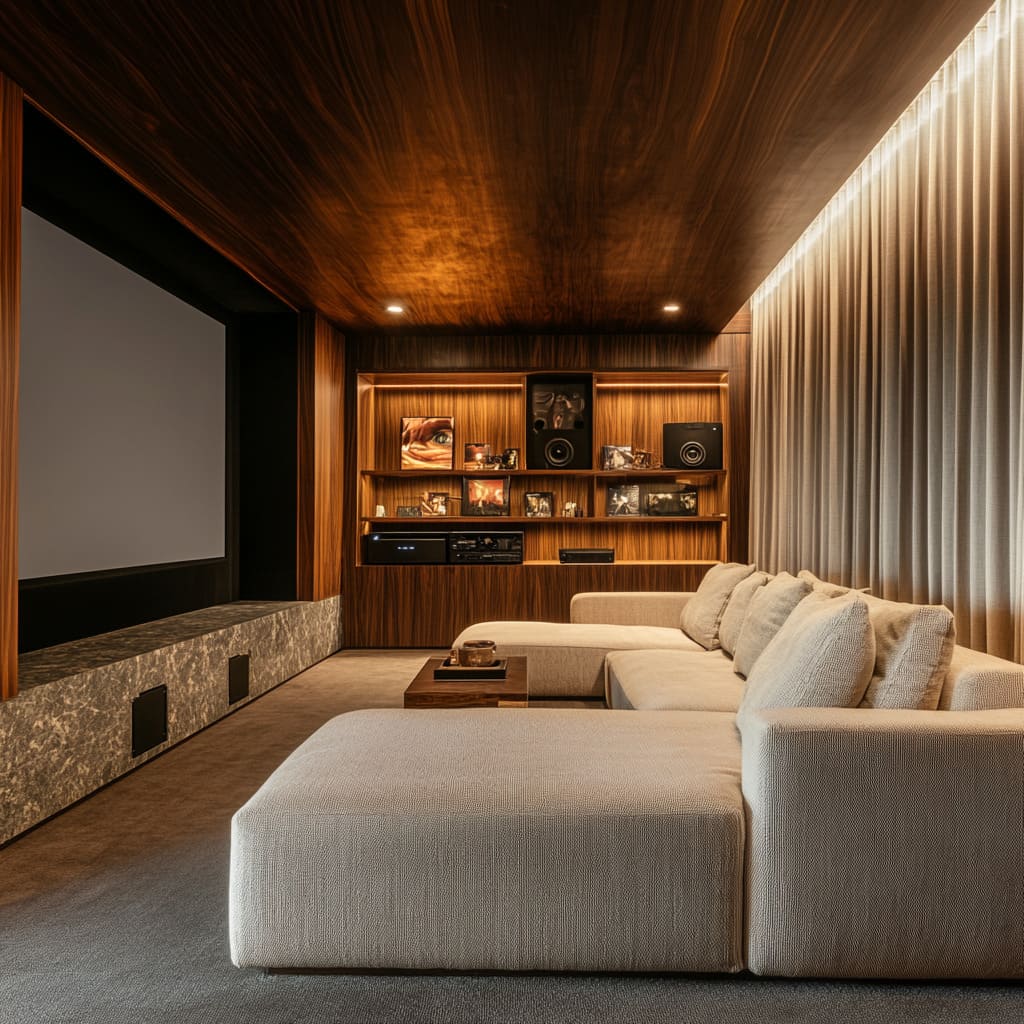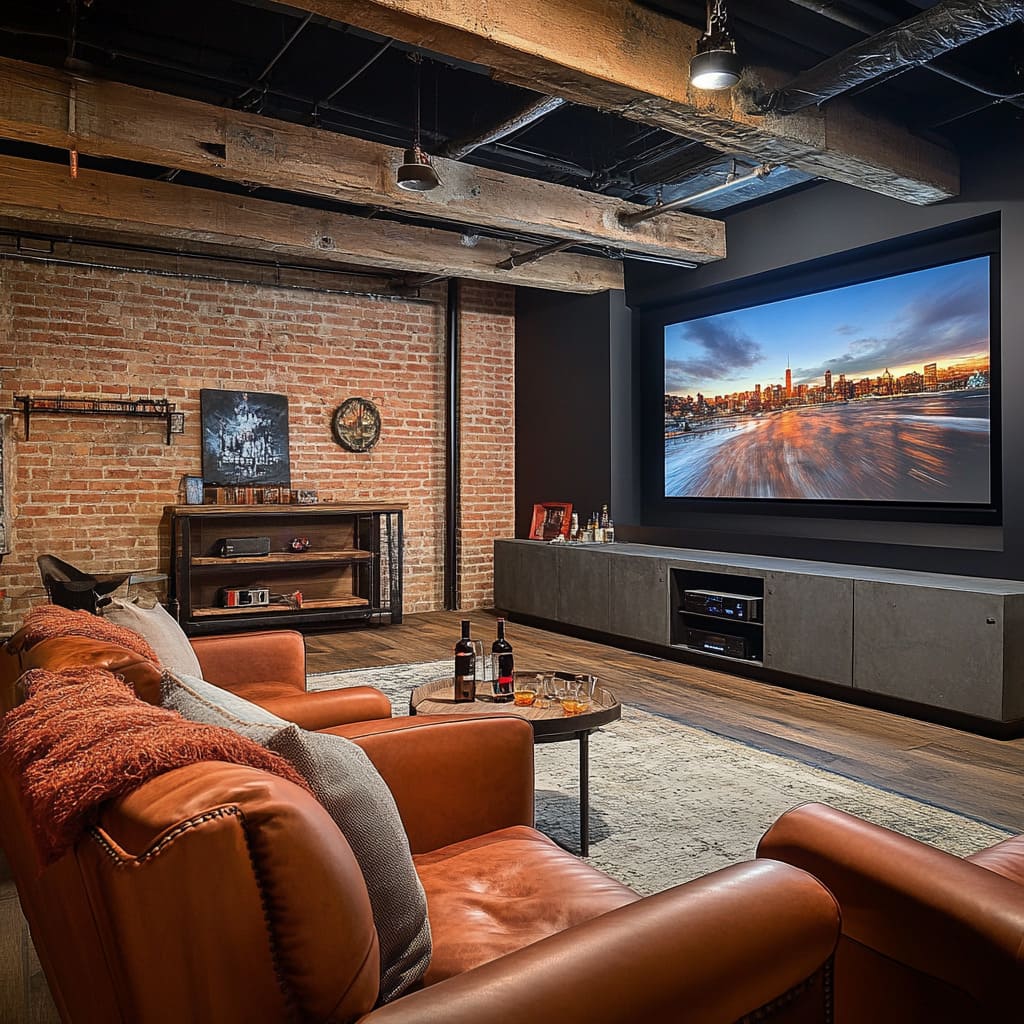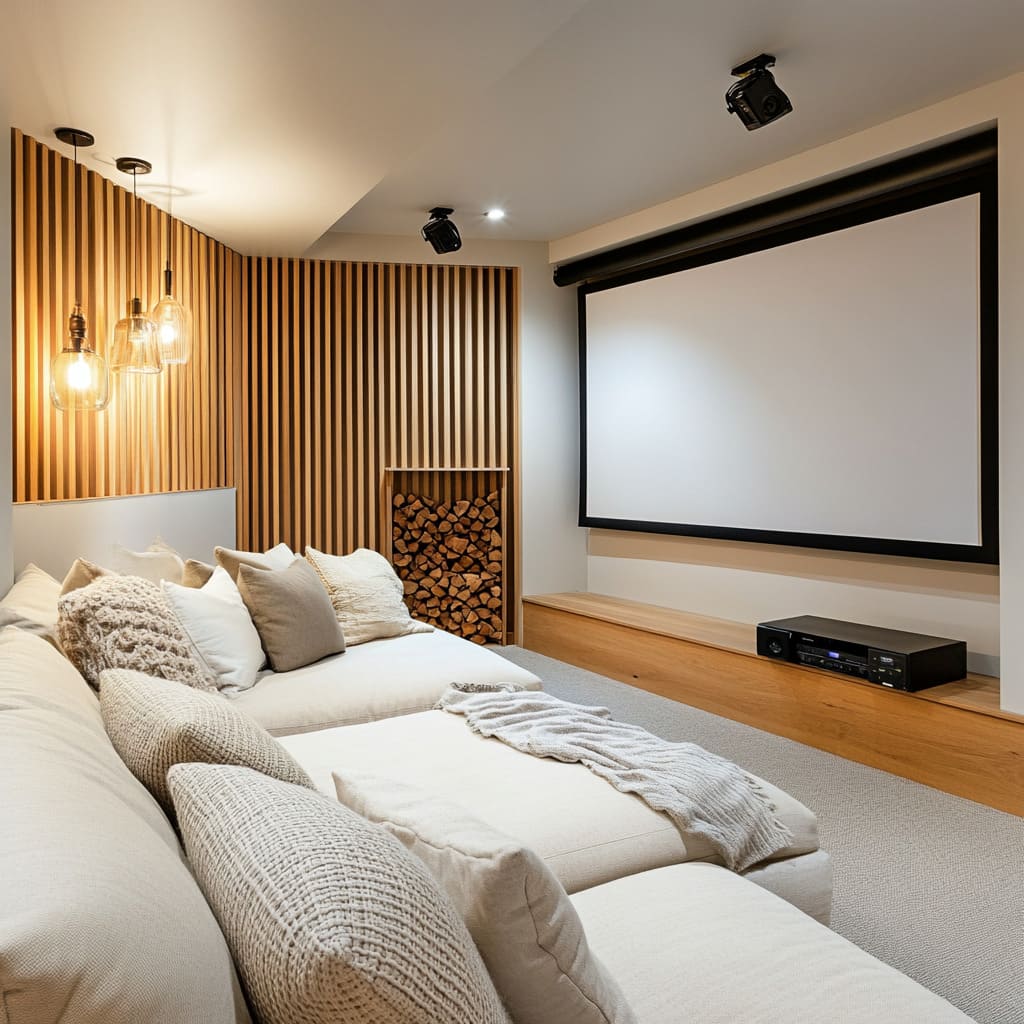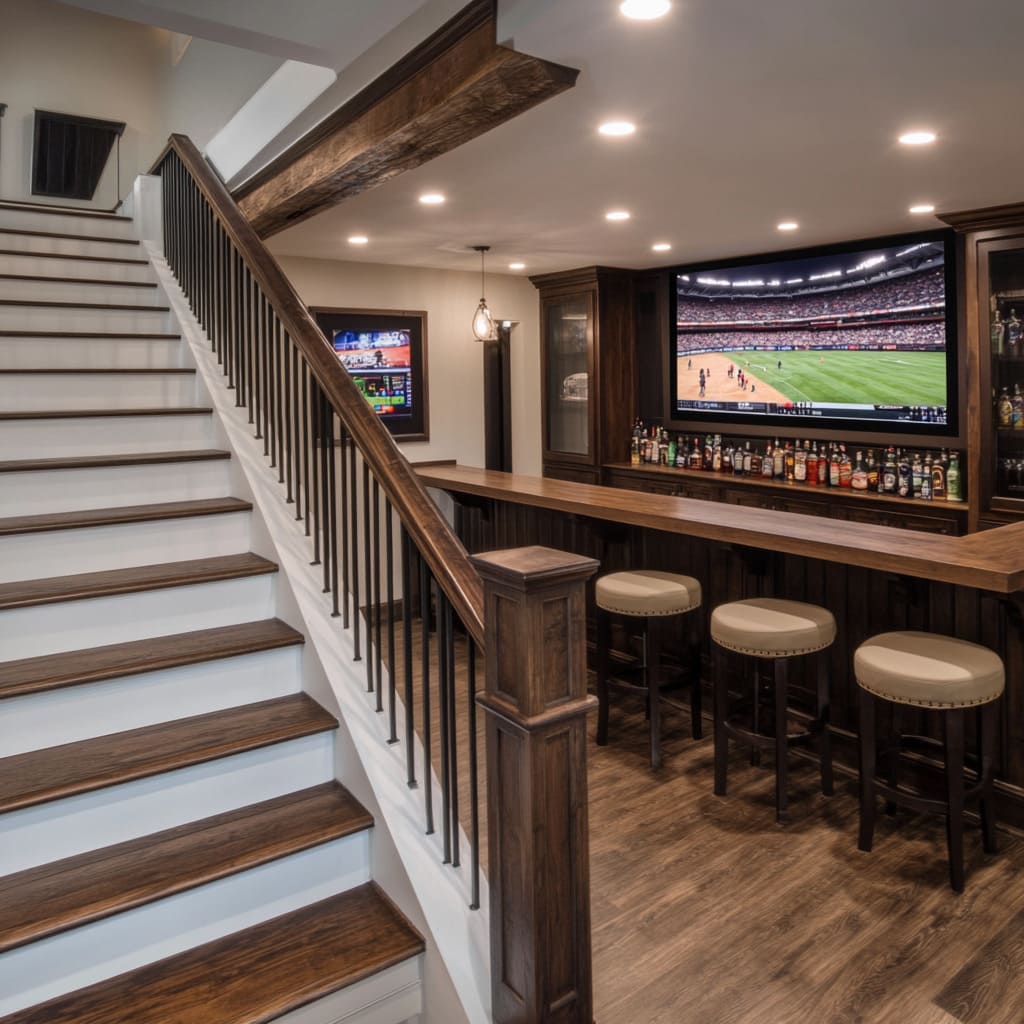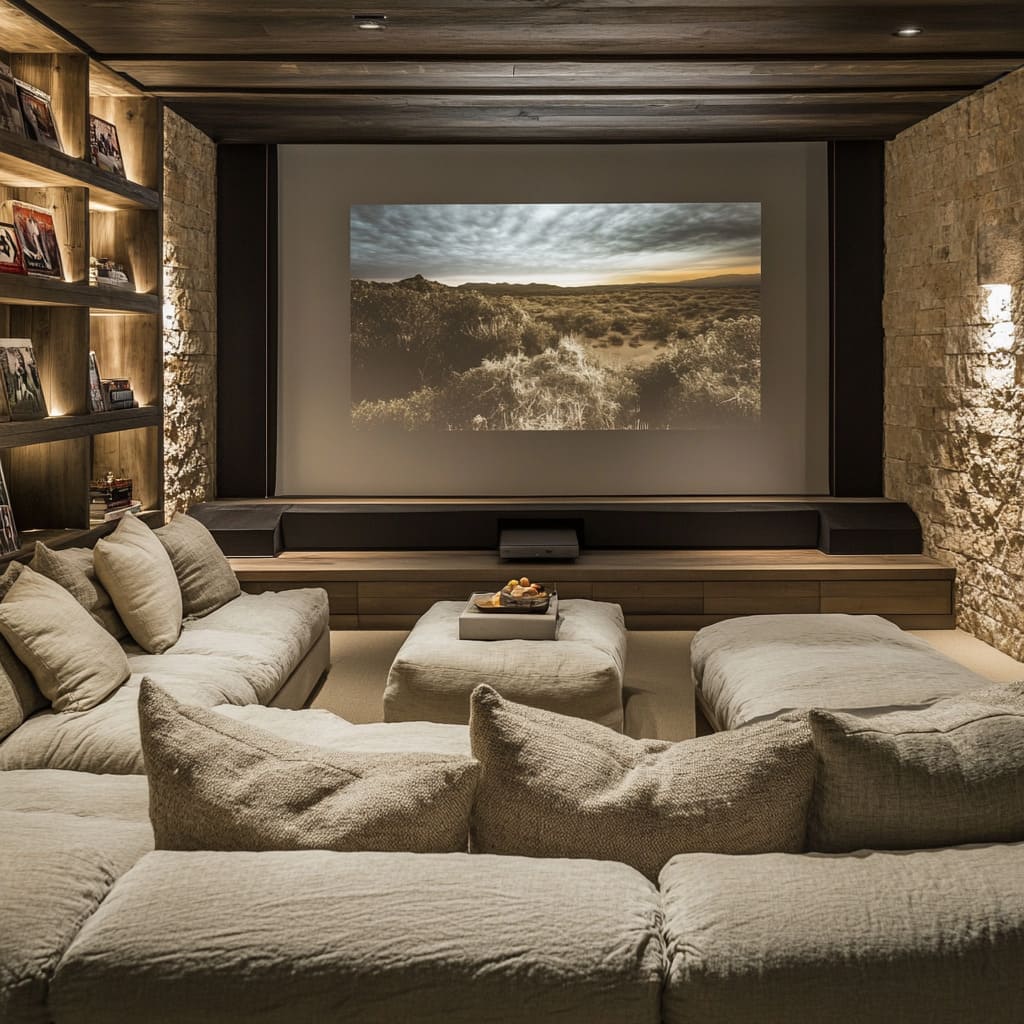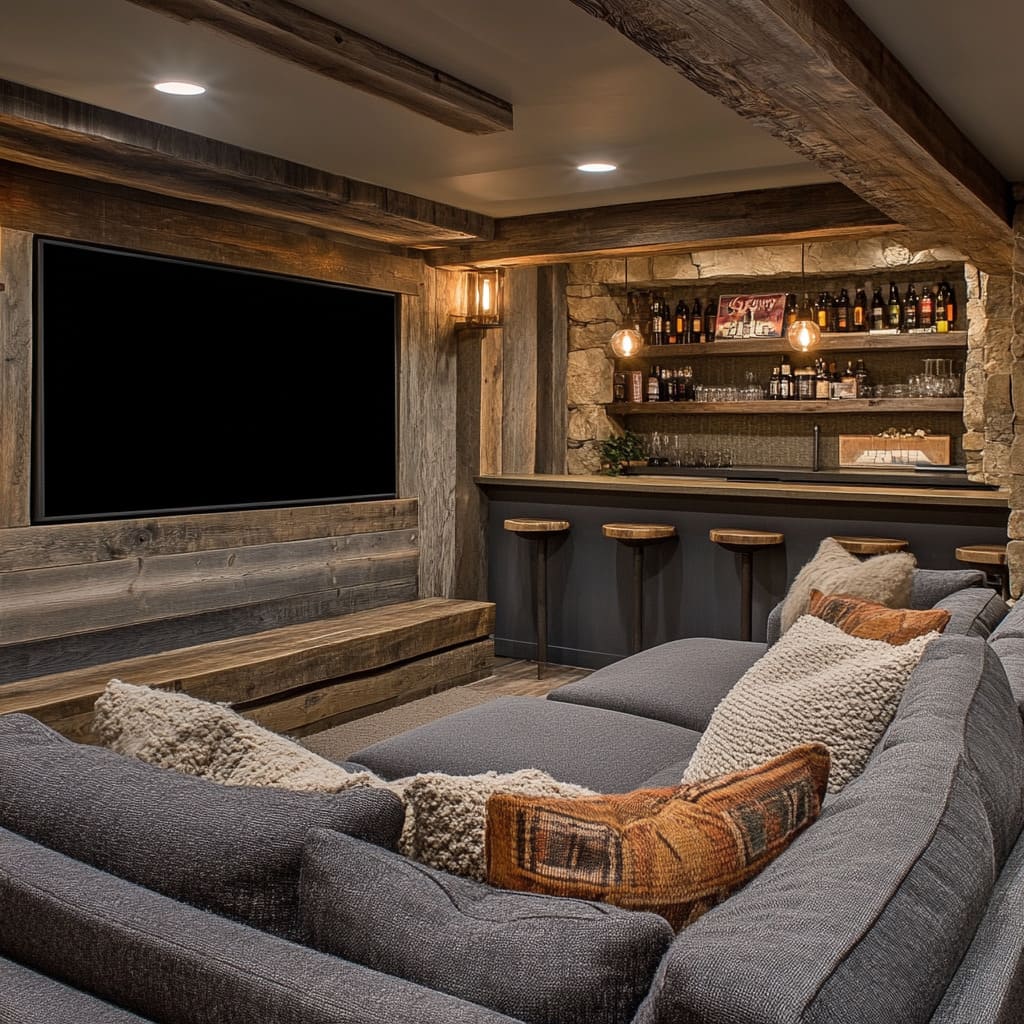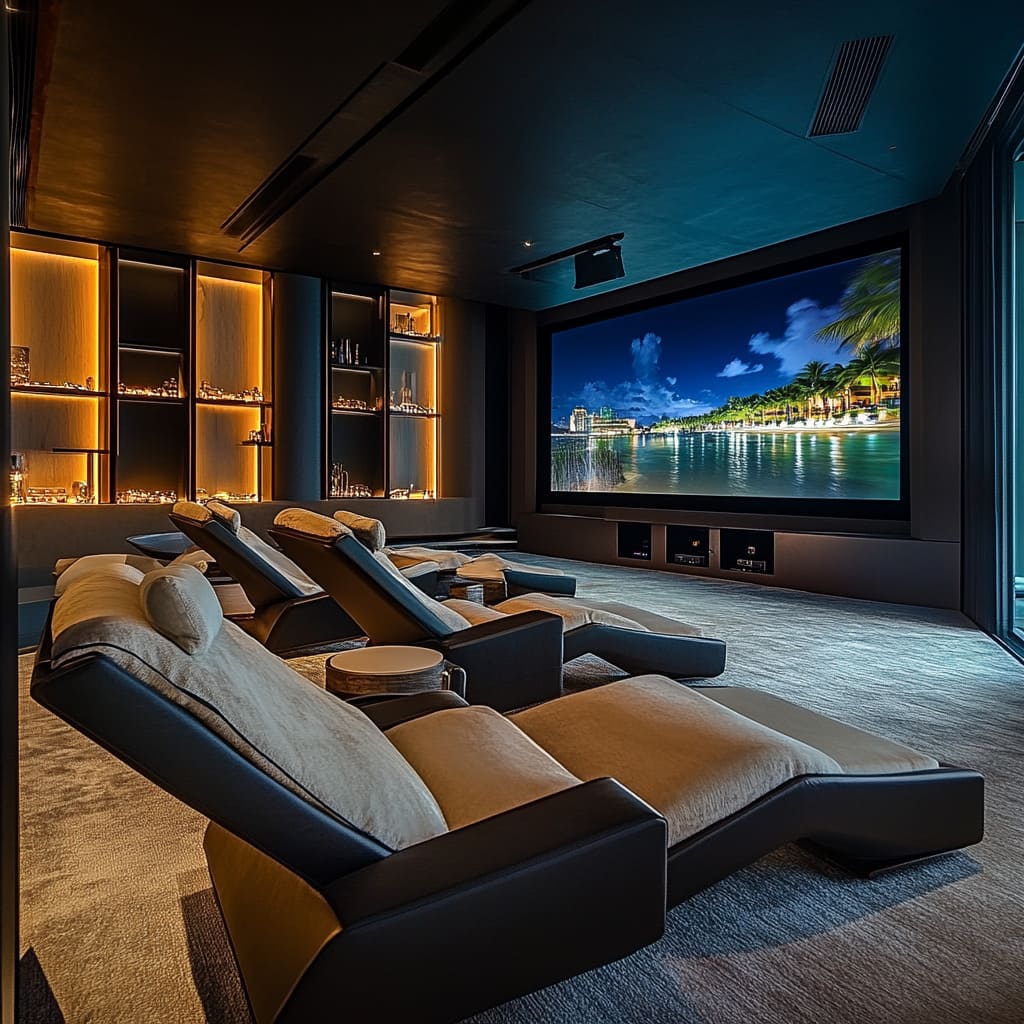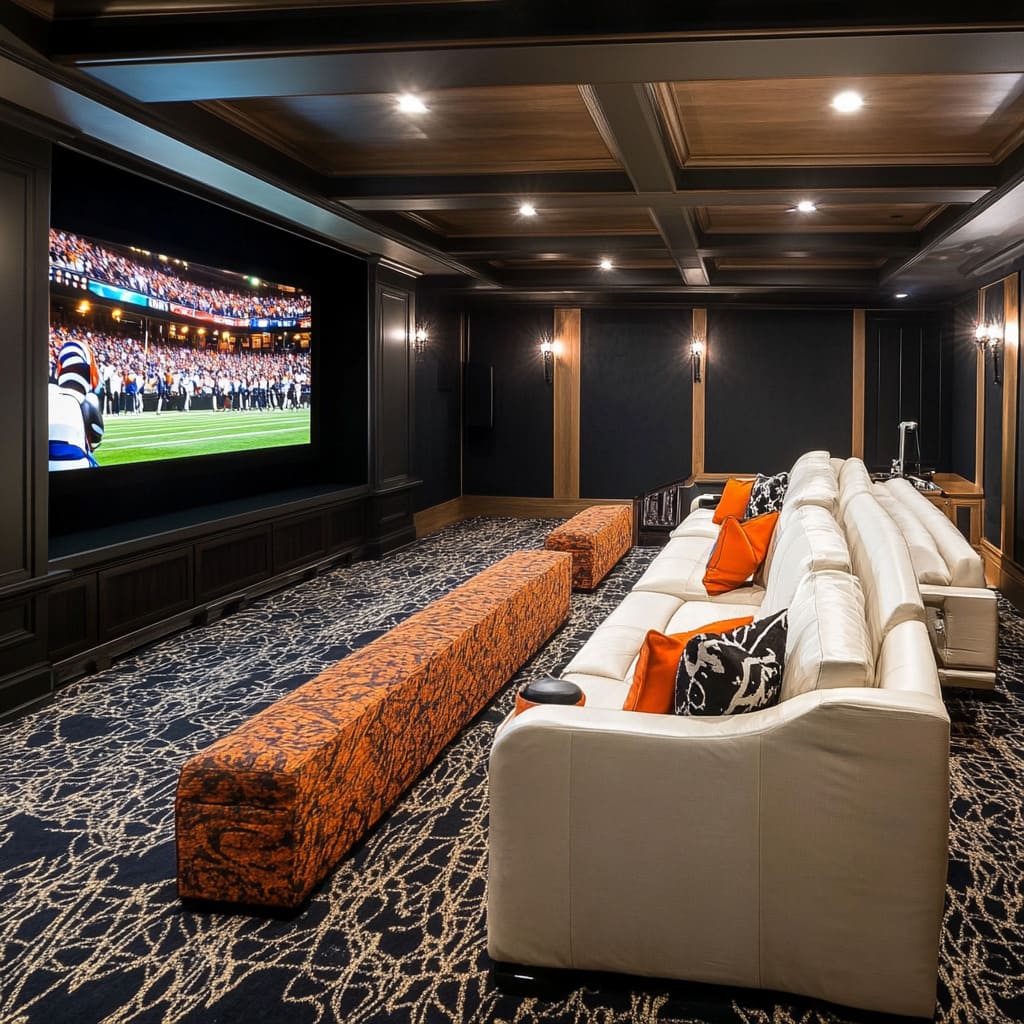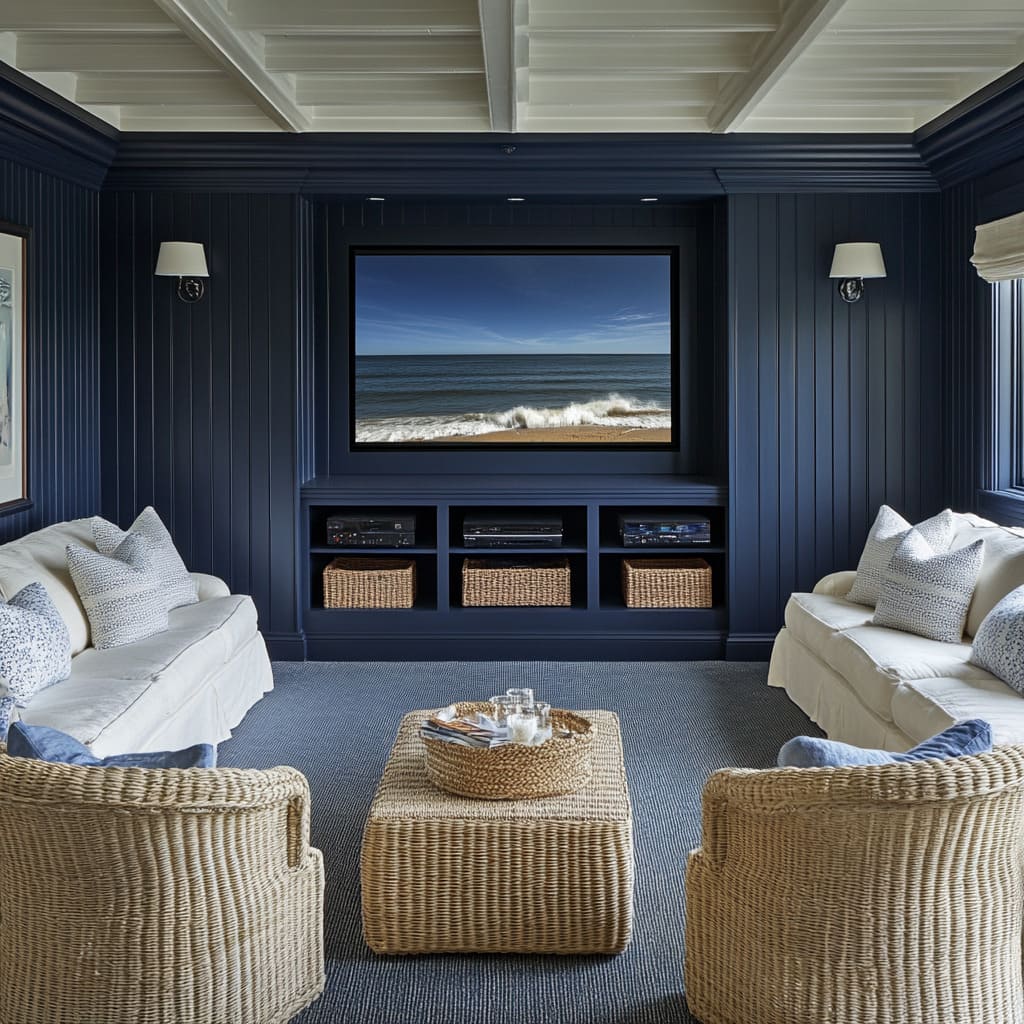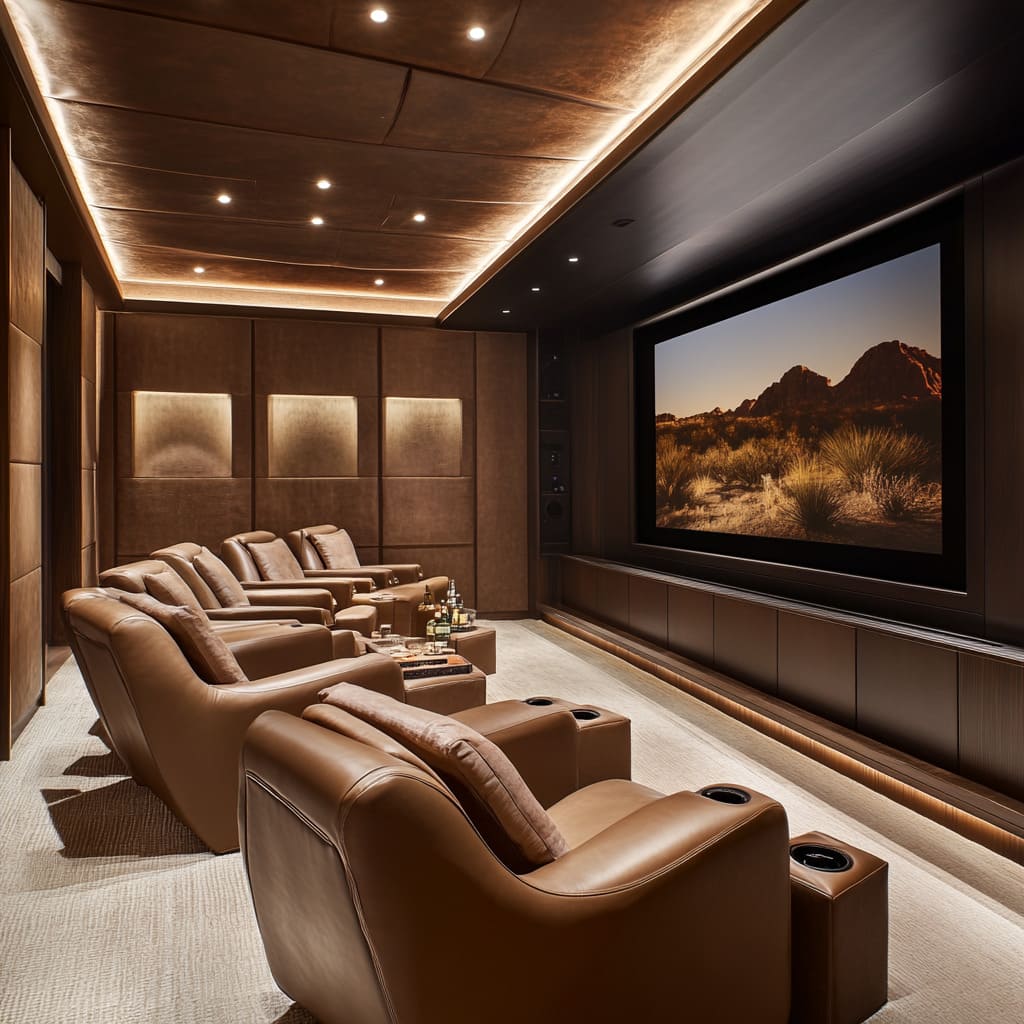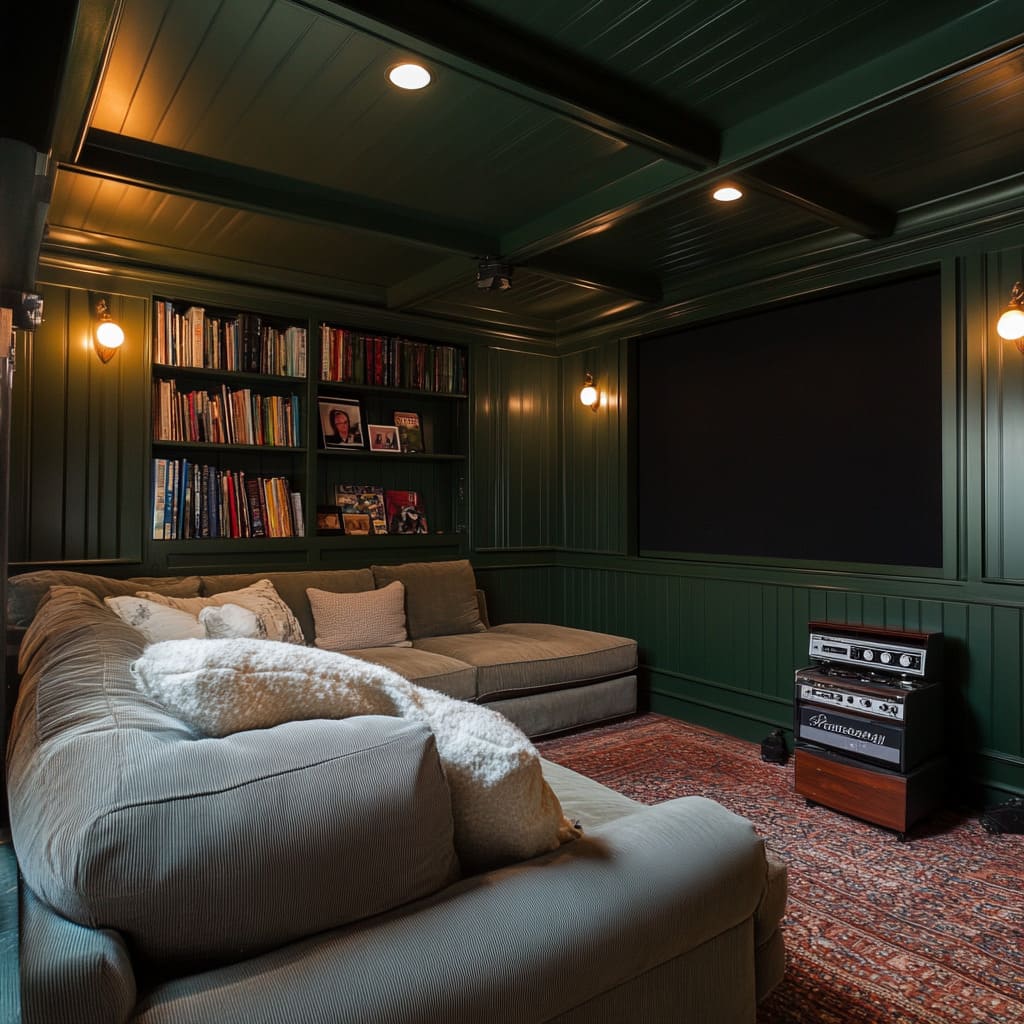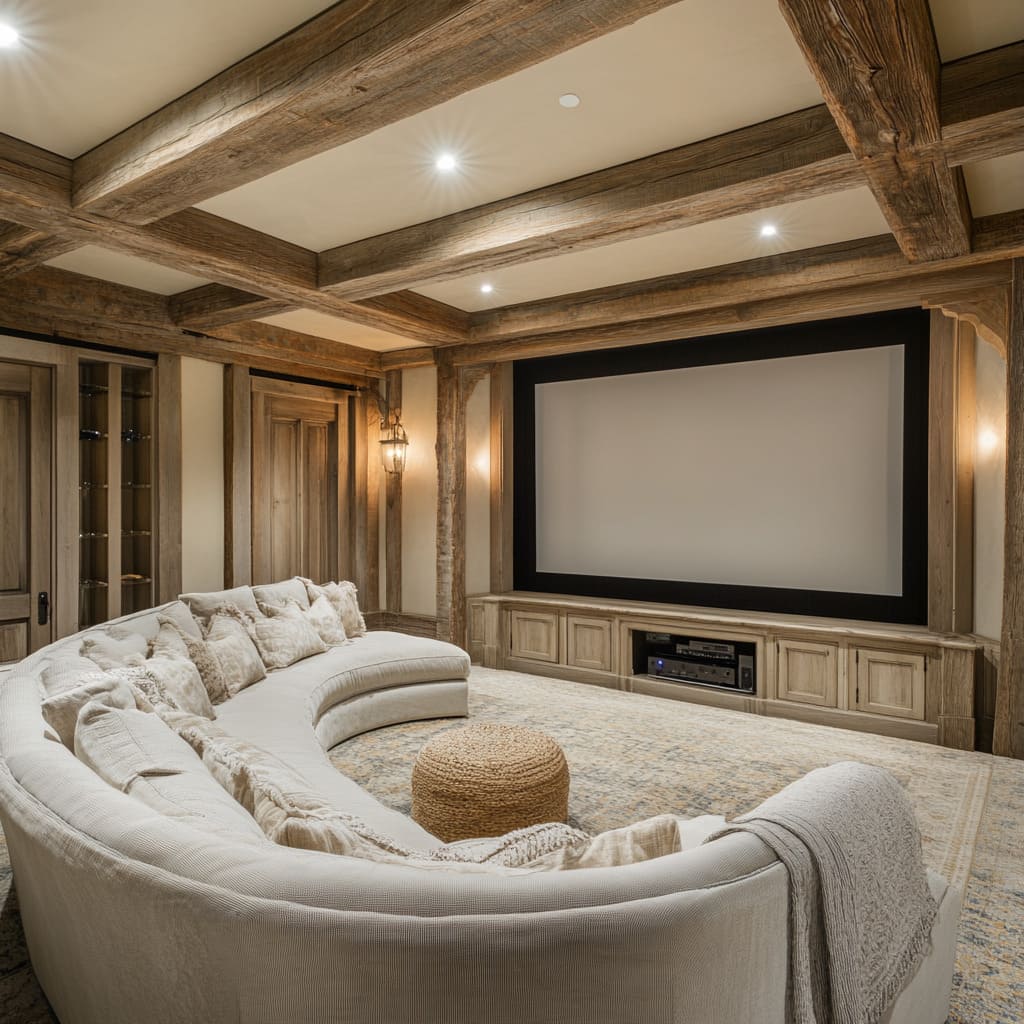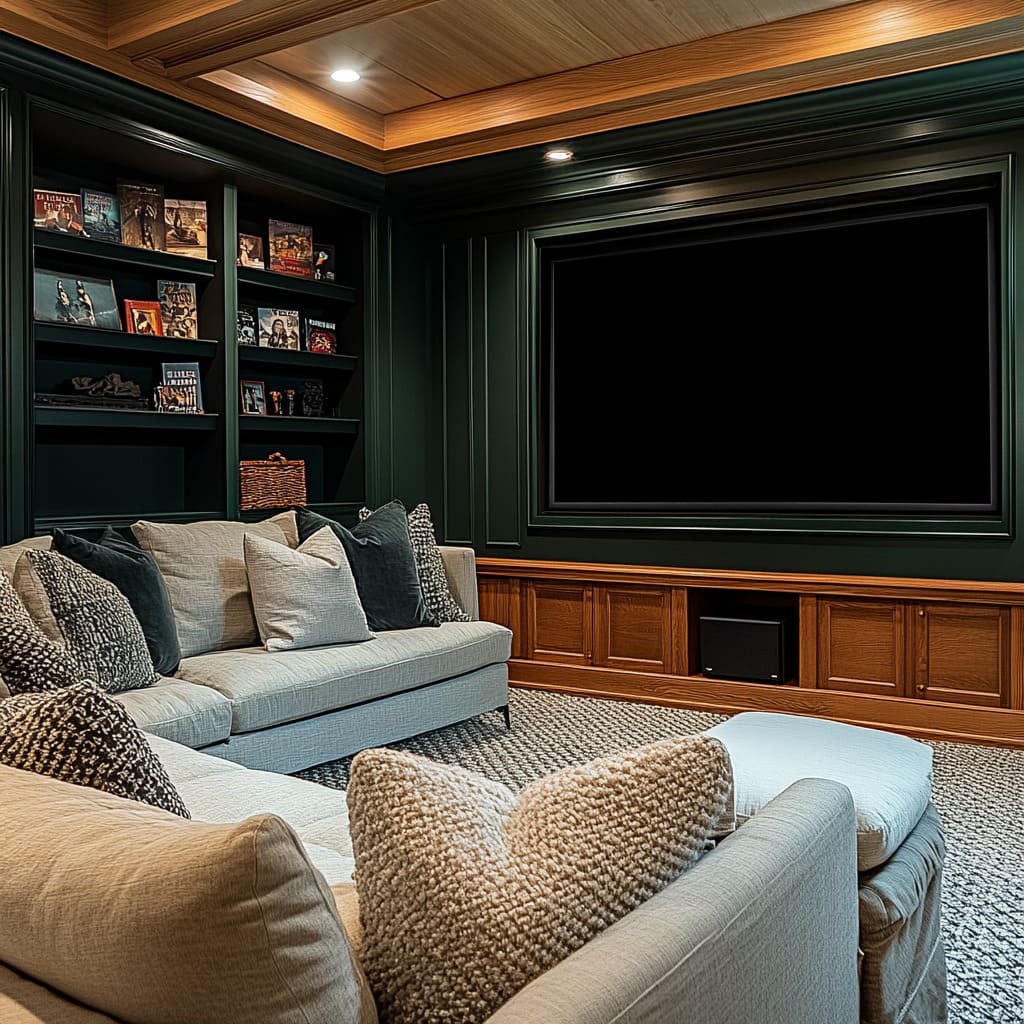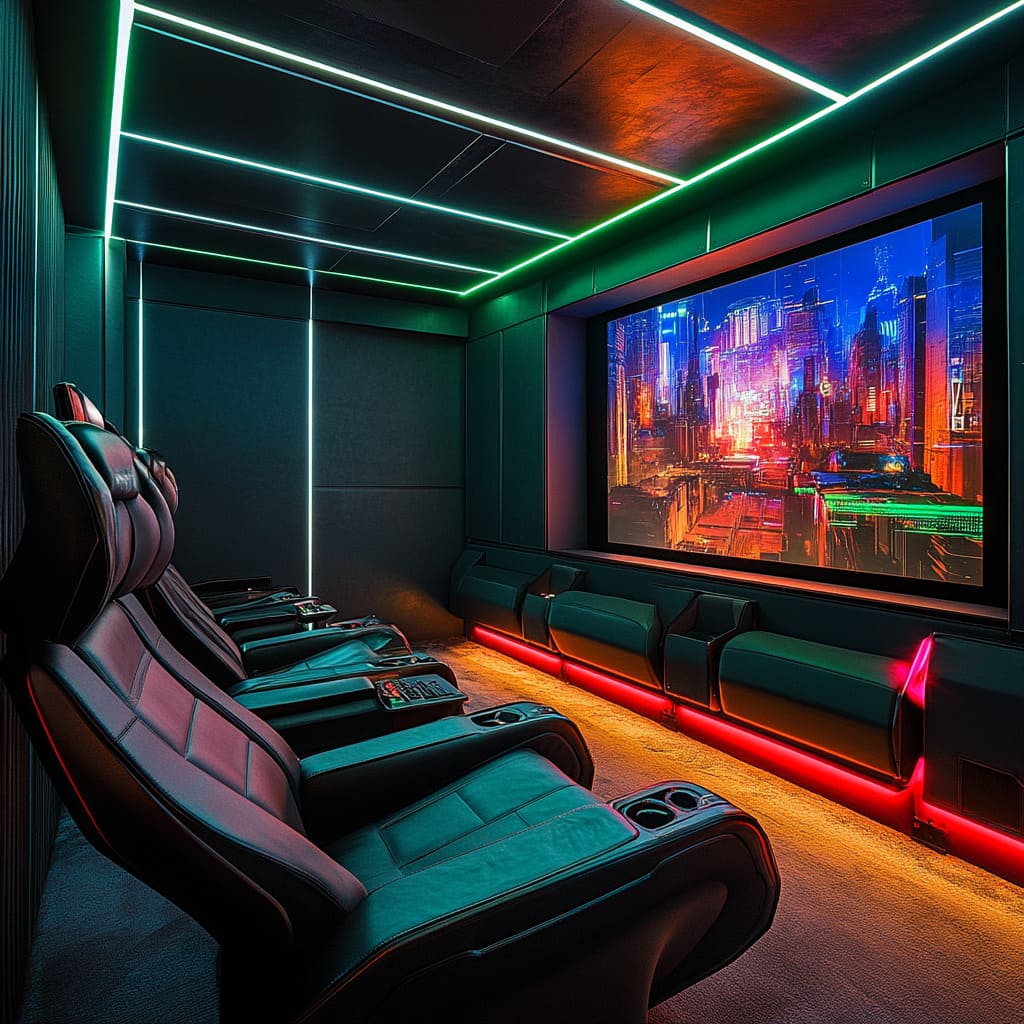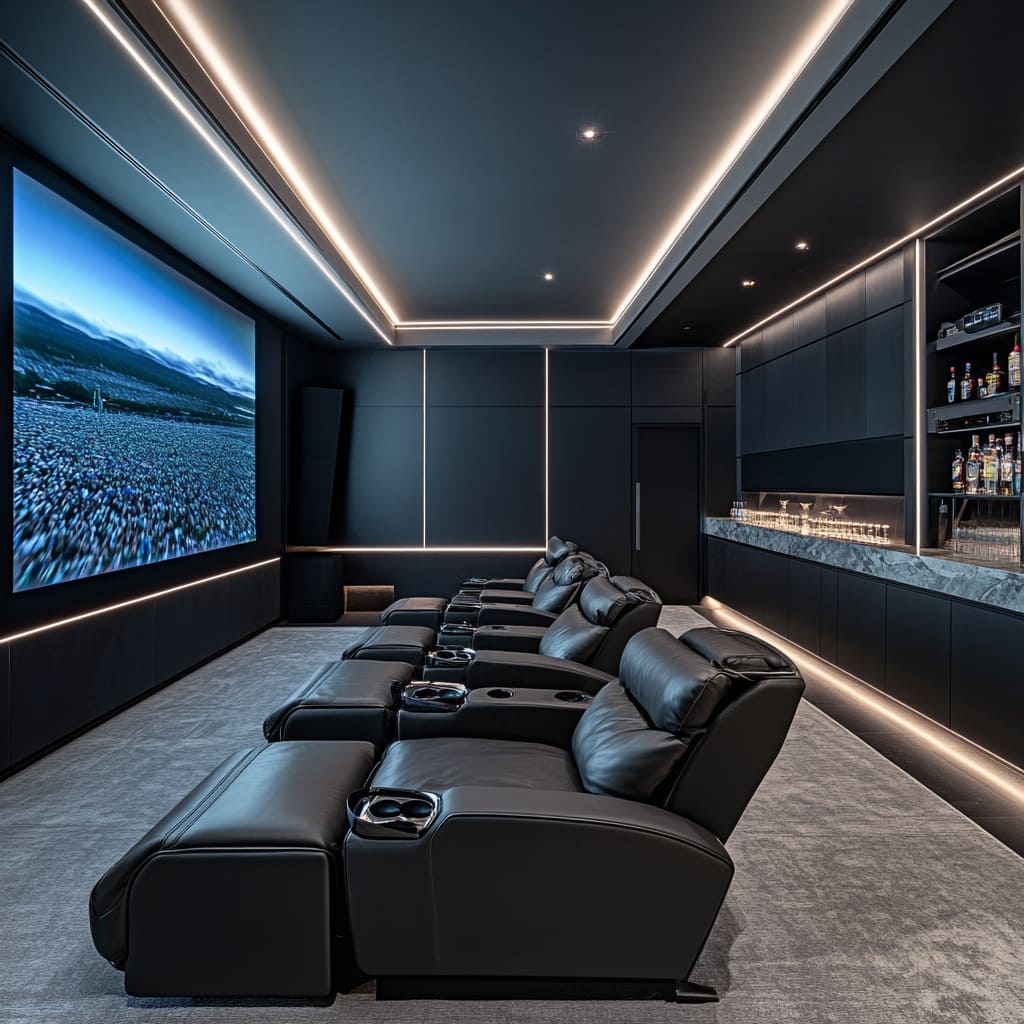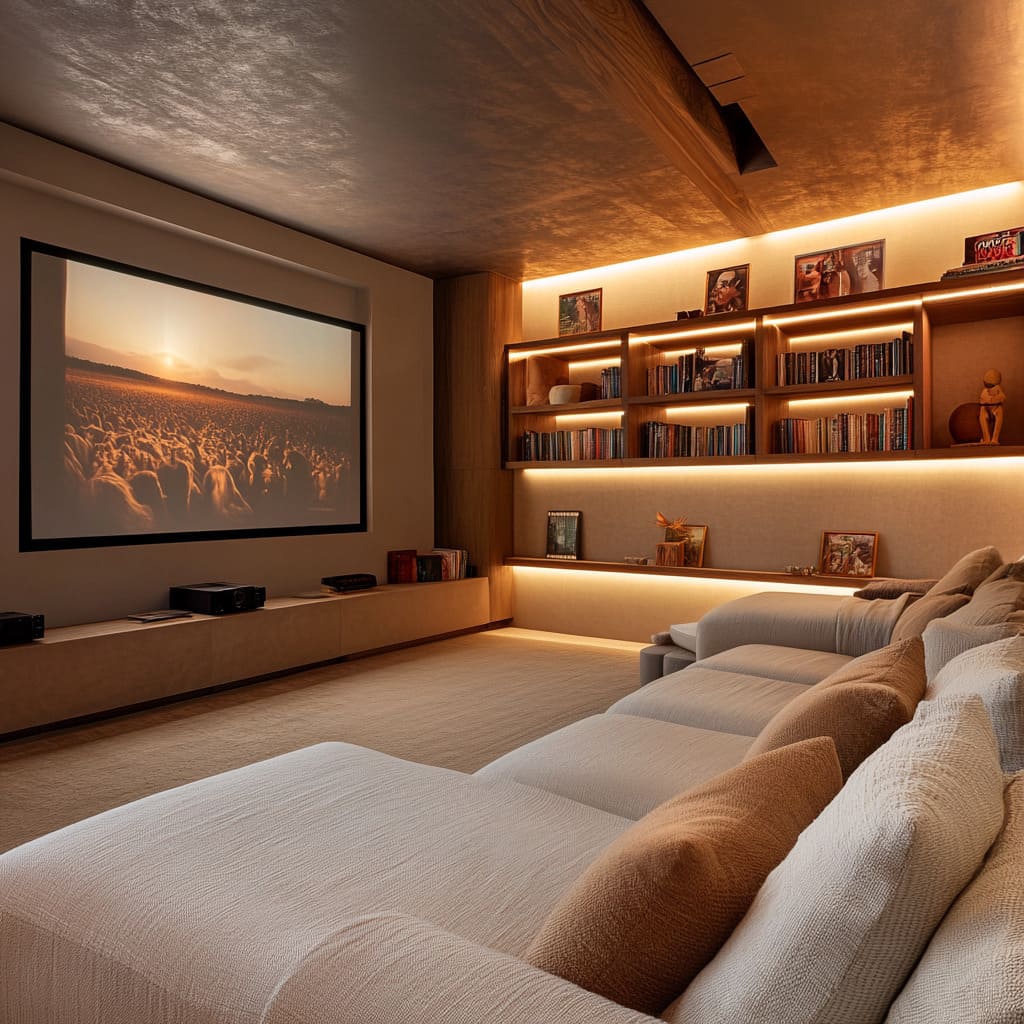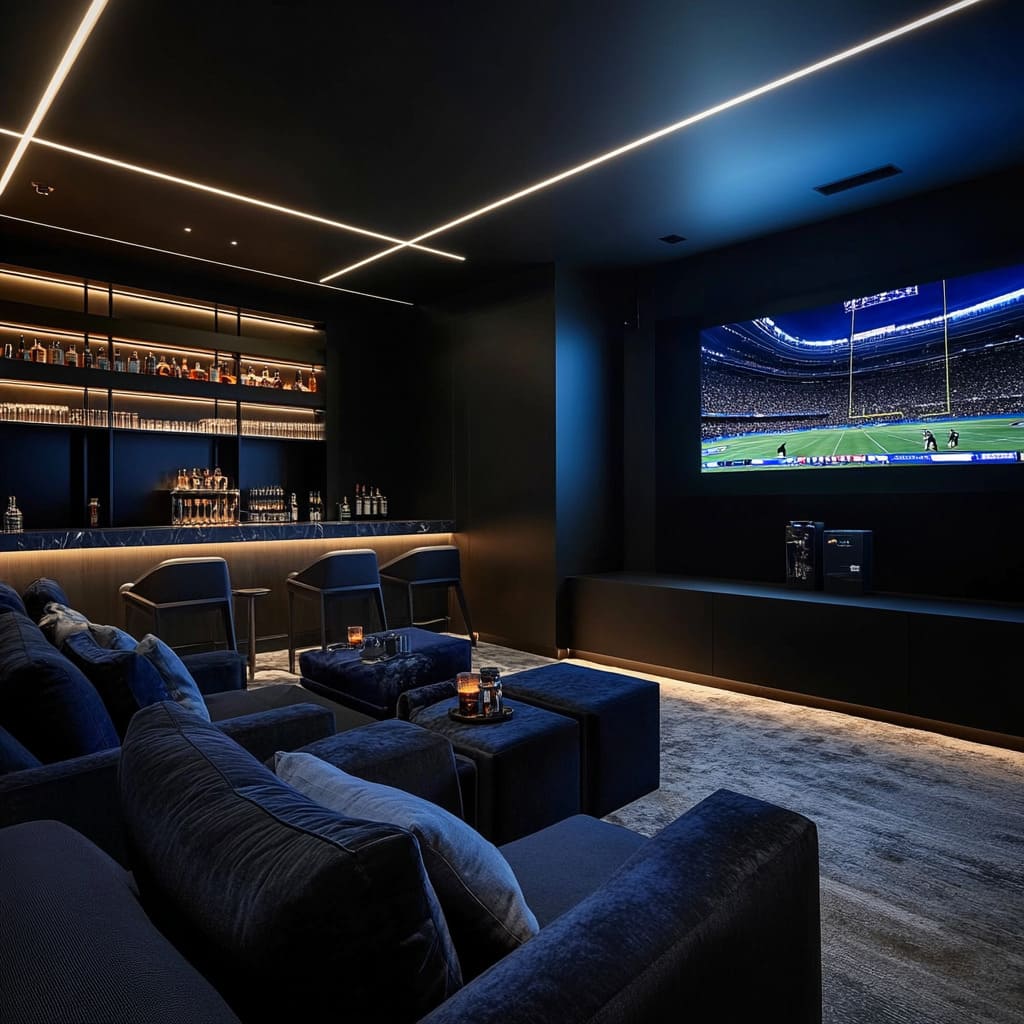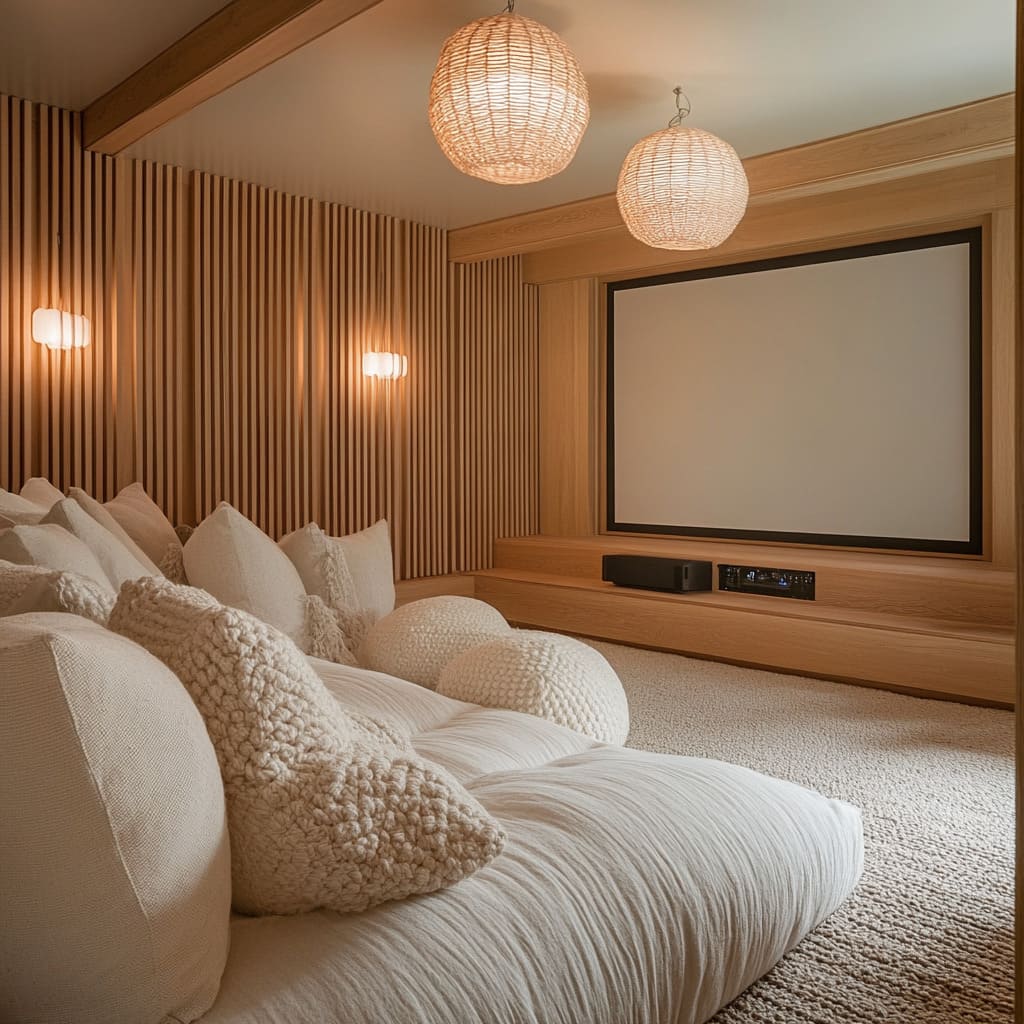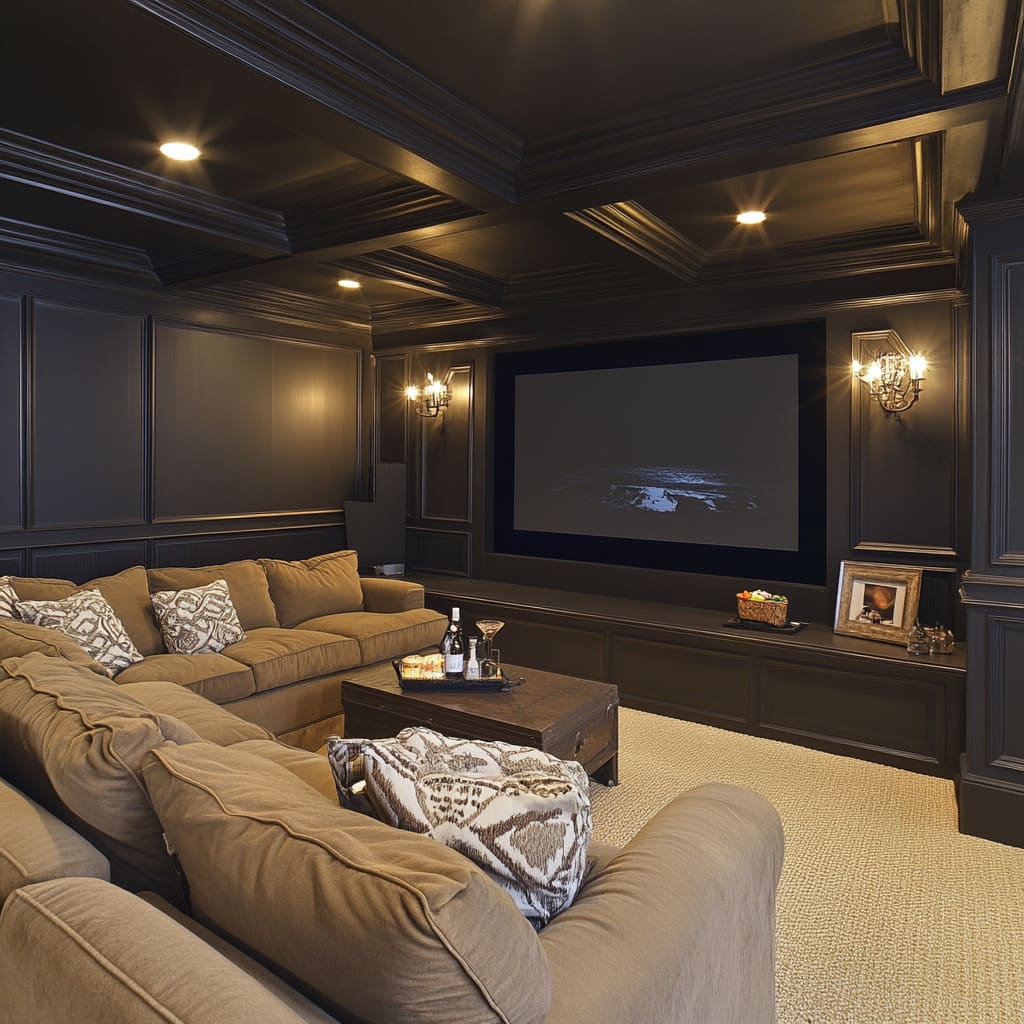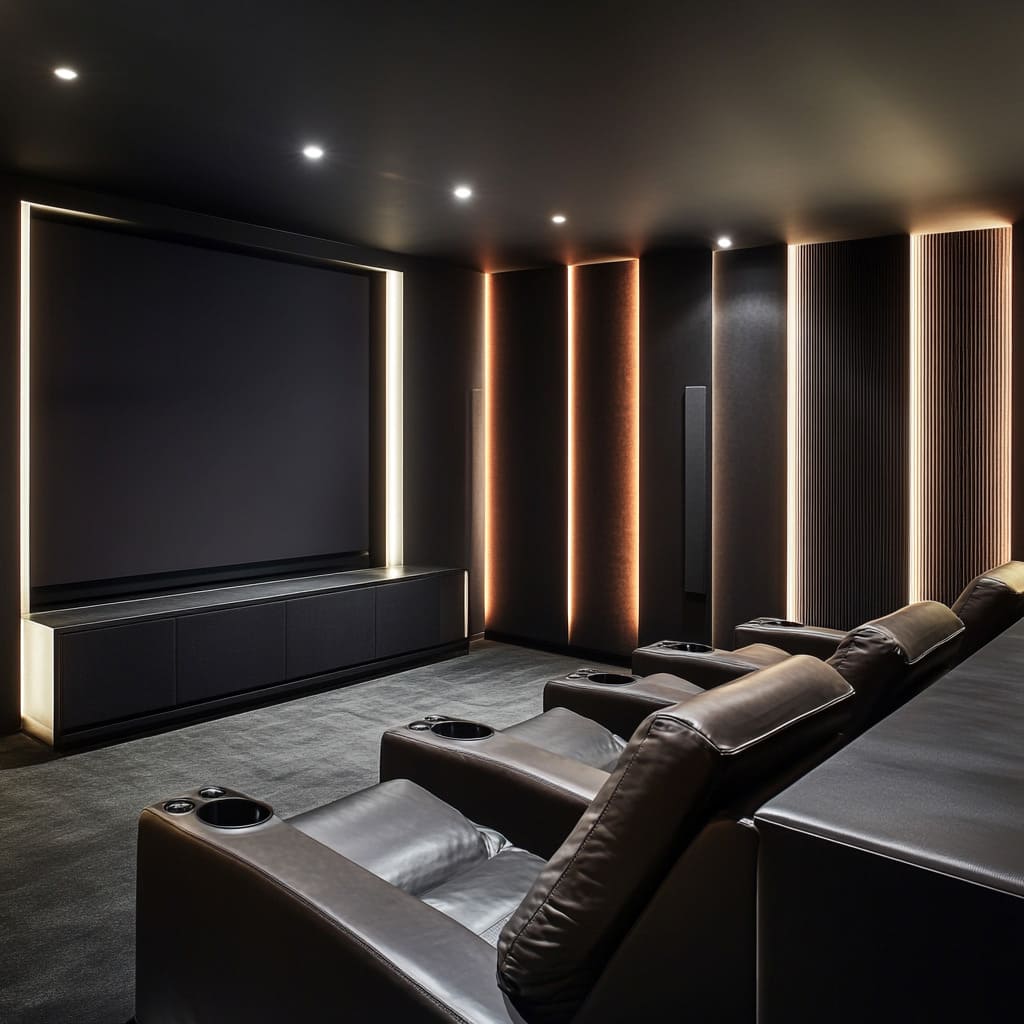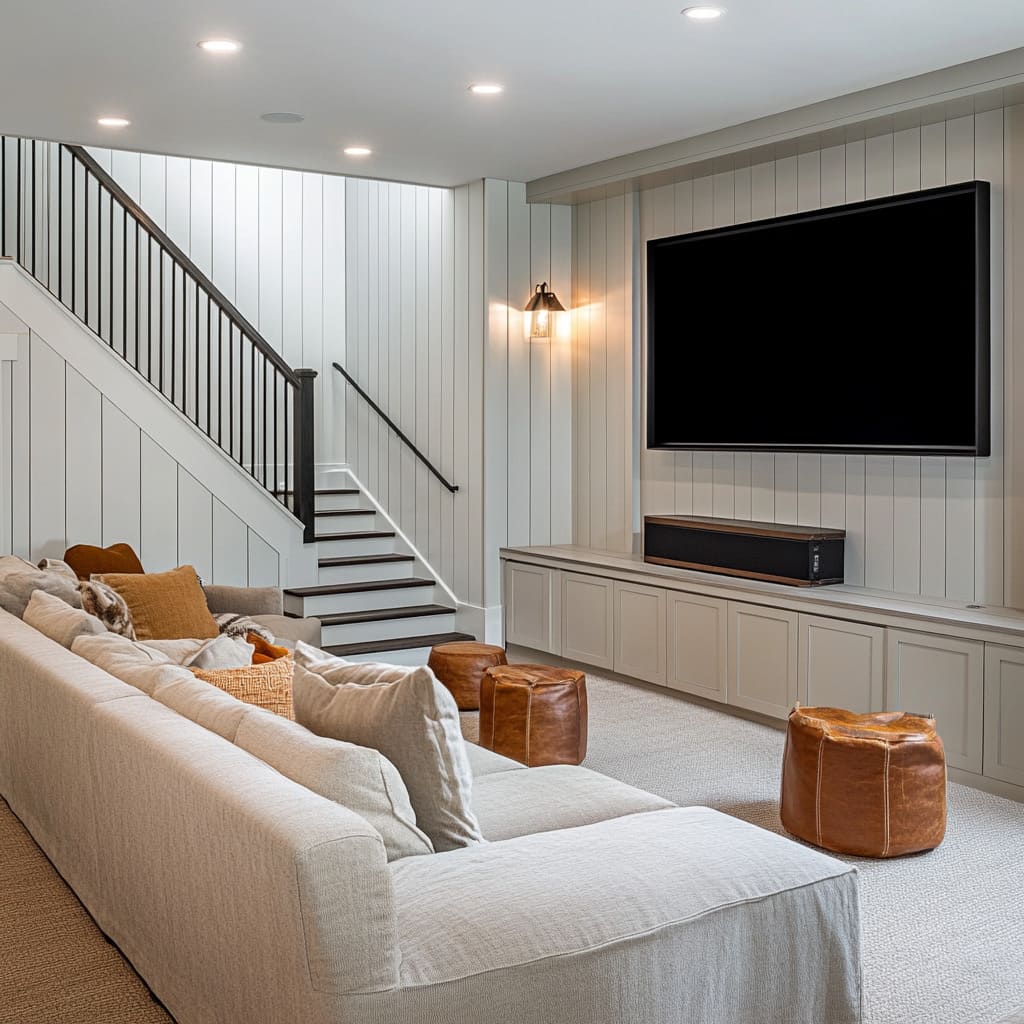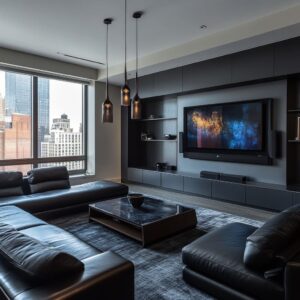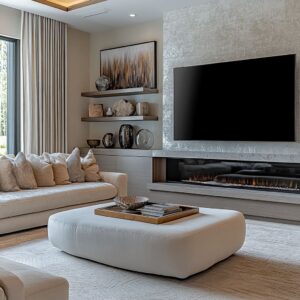A home theater isn’t just about watching movies—it’s about creating a space that feels immersive, comfortable, and suited to your lifestyle. Whether you prefer a sleek modern look, a cozy lounge-inspired setup, or a traditional cinema feel, every design choice plays a role in shaping the experience.
From seating arrangements to lighting and acoustic treatments, the right home theater ideas make all the difference.
Some designs focus on high-tech elements like integrated LED lighting and concealed speakers, while others lean into natural textures, warm wood finishes, and relaxed seating for a more inviting atmosphere. The key is finding a balance that matches your taste and the way you use the space.
This guide breaks down the details—what works, what adds to the atmosphere, and how to build a theater that looks great and functions flawlessly. Whether you’re starting from scratch or upgrading an existing setup, these ideas will help you create a space where every movie night feels like an event.
Multifunctional Spaces and Bar Integration
Designing a home theater doesn’t mean limiting the space to just movie-watching. Many setups successfully combine a viewing area with a functional bar or lounge, creating a space that feels inviting and dynamic.
The idea that a home theater must be fully enclosed is outdated—some of the best theater room ideas embrace a more social atmosphere, allowing guests to move freely between watching a film and enjoying a drink.
Blending Entertainment with Social Interaction
One of the standout features in certain home theater designs is the seamless integration of a bar or lounge area. This is especially common in layouts inspired by classic sports bars, where the bar acts as both a visual anchor and a gathering spot.
Positioned at the back or side of the room, it allows guests to chat or grab refreshments without disrupting the screen. Well-placed secondary screens can enhance the experience, ensuring that no one misses key moments of a game or movie.
Movement and Visual Flow
When designed thoughtfully, a home theater doesn’t just serve as a single-purpose space—it flows into other areas, making it feel more open and connected. The presence of an L-shaped staircase next to a bar or seating area adds a natural sense of movement while subtly defining different zones.
When the staircase materials are coordinated with the bar, whether through matching wood tones or complementary finishes, the design feels cohesive rather than disjointed.
Durability Matters
A home theater with a social function naturally sees more activity—drinks are poured, snacks are shared, and people move around more frequently. This makes material choices critical.
Dark-stained wood bars, thick countertops, and high-quality, easy-to-clean upholstery are all practical decisions that keep the space looking refined while being functional. Choosing durable surfaces means less worry about spills or wear over time.
Bringing the Concept to Life
- Incorporate Bar-Height Counters: If space allows, a bar-height counter positioned behind the main seating row creates an additional tier of seating. This works especially well in longer rooms, where guests can comfortably watch the screen without obstructing the view for others.
- Match Materials for a Cohesive Look: Small details make a difference—aligning the wood tones of your staircase, bar, and flooring creates a natural flow. Even a slight variation in stain or texture can enhance the overall aesthetic and make the space feel intentionally designed.
- Use Layered Lighting for Atmosphere: A well-designed bar area needs more than just a bright overhead fixture. Combining pendant lights for ambiance, task lighting for mixing drinks, and hidden LED strips for a soft glow ensures the space adapts to different occasions. Dimmable options allow a seamless shift from movie mode to social gatherings without disrupting the atmosphere.
By blending entertainment and functionality, a home theater can become more than just a space for watching films—it transforms into a stylish, inviting hub where guests can enjoy both movies and conversation.
Emphasis on Dark, Dramatic Aesthetics
Creating a home theater with a deep, moody atmosphere goes beyond just choosing a dark color palette—it’s about crafting an environment where the screen becomes the focal point, lighting is used with intention, and every surface enhances the viewing experience. Many home movie theater ideas embrace this bold approach, proving that an all-black or charcoal-toned space isn’t just about aesthetics but also performance.
Why Darkness Works
Dark tones in a home theater do more than add a stylish, dramatic edge—they actively improve screen visibility. Black walls, ceilings, and carpets absorb excess light rather than reflect it, preventing glare and keeping distractions to a minimum.
Even elements like matte finishes and soft-textured fabrics contribute by reducing reflections, ensuring that the projected image or TV screen remains sharp and vibrant.
Minimalist Forms with a Strong Lighting Impact
When working with a darker color scheme, lighting design takes center stage. Instead of relying on traditional fixtures, these spaces often feature LED strips embedded in walls, ceiling lines, or under furniture.
Since the surroundings are subdued, even the smallest glow creates a striking effect. Straight lines and geometric shapes enhance this visual play, ensuring the room feels intentionally designed rather than just dimly lit.
Keeping Technology Hidden
To maintain a sleek and refined look, many designs opt for concealed technology. Projectors and speakers are often integrated into cabinetry or hidden behind acoustically transparent fabric panels.
This keeps the space looking clean and uninterrupted while still delivering high-quality sound and visuals. Built-in media consoles, recessed shelving, and discreet wall-mounted controls ensure that only the essentials are visible.
How to Achieve This Look
A dark, dramatic home theater is all about balance—minimizing distractions while making the most of lighting, textures, and hidden technology. When done right, it’s a space that feels immersive, modern, and perfect for long movie nights.
LED-Focused, Futuristic Concepts
For those who want a home theater room design that feels ultra-modern, LED lighting is the foundation of a high-tech aesthetic. More than just decoration, these illuminated accents help define different areas within the space while reinforcing the sleek, cutting-edge vibe.
When integrated correctly, they enhance both functionality and atmosphere, transforming a theater into an immersive environment.
Strategic Lighting for Defined Spaces
One of the most effective ways LED lighting is used in futuristic home theaters is to outline specific zones. Instead of traditional walls or partitions, subtle lighting changes can visually separate seating areas, bar sections, and pathways.
Geometric ceiling patterns with embedded LED strips not only add architectural interest but also give the room a sense of depth. The same effect can be applied to shelving, floor borders, or even recessed wall panels, creating a structured yet fluid design that eliminates the need for physical barriers.
High-Tech Features and Automation
These futuristic setups often extend beyond lighting to incorporate smart home automation. Seating with motorized recline, hidden in-wall speakers, and synchronized lighting effects are all controlled through centralized systems.
This level of integration doesn’t happen by accident—it requires thoughtful planning of wiring, outlets, and control hubs early in the design process. A well-coordinated system allows lighting to adjust based on the activity, whether it’s dimming automatically when a movie starts or shifting color temperatures for a different mood.
Acoustic Panels with a Visual Edge
Many of these designs feature modular wall panels that don’t just look stylish but also serve an acoustic function. LED inserts within these panels add a glowing outline, while the panels themselves are made from sound-absorbing materials that prevent echoes and enhance audio clarity.
This approach blends aesthetics with performance, ensuring that the lighting doesn’t interfere with the cinematic experience.
Bringing the Vision to Life
- Keep LED Color Temperatures Consistent: Mismatched lighting can break the seamless feel of a futuristic theater. If cool-toned blue and white LEDs are used in one area, mixing in warm amber lights elsewhere can create a jarring effect. Keeping a unified color temperature throughout the space maintains harmony and enhances the immersive quality.
- Plan for Maintenance and Accessibility: While LED strips are long-lasting, they aren’t invincible. To avoid tearing apart walls or ceilings when replacements are needed, include easily accessible wiring channels or removable panels. This ensures long-term functionality without requiring major reconstruction.
- Balance High-Tech with Natural Elements: While an LED-heavy setup leans modern, incorporating natural materials can prevent it from feeling overly sterile. A wood-paneled wall, a leather sectional, or a stone coffee table can add warmth and contrast, making the space more inviting while still retaining its futuristic character.
A well-designed futuristic home theater isn’t just about cool lighting—it’s about precision. Thoughtfully placed LEDs, seamless automation, and acoustic-conscious materials create a space that looks impressive but also functions at the highest level.
Nature-Inspired or Relaxed Retreats
A home theater doesn’t always have to be dark and dramatic—some designs take inspiration from nature, creating a space that feels warm, inviting, and effortlessly comfortable. By incorporating organic materials, soft seating arrangements, and natural lighting elements, these theaters offer a fresh take on entertainment spaces.
Whether influenced by Zen simplicity, Scandinavian coziness, or rustic warmth, these designs focus on relaxation as much as functionality.
The Beauty of Wood and Natural Textures
Slatted wood walls and reclaimed planks play a crucial role in these spaces, bringing in a tactile quality while improving acoustics. The spacing between slats helps diffuse sound, preventing harsh echoes and creating a more balanced audio experience.
Beyond function, wood introduces a visual softness that blends seamlessly with woven textiles, neutral-toned fabrics, and handcrafted decor. As an added bonus, slatted panels can cleverly conceal wiring and speakers, keeping the setup clean and uncluttered.
A Different Approach to Seating
Instead of traditional recliners arranged in rows, relaxed home theaters embrace more casual seating options. Built-in sofas, deep bench seating, or even plush floor cushions create a cozy, lounge-like atmosphere rather than a rigid theater setup.
This is especially common in Japanese and Scandinavian-inspired designs, where seating encourages a more immersive experience. Thinking outside the box with media room seating ideas allows for a more flexible space—perfect for movie nights, reading, or simply unwinding.
Bringing in Natural Light
While most people assume a home theater should be completely closed off, some designs integrate large windows that can be covered with blackout curtains when needed. This approach transforms the room from a purely nighttime space to a bright and airy retreat during the day.
Natural light makes the space feel less enclosed, while soft linen or woven shades keep the ambiance relaxed.
How to Achieve This Look
A nature-inspired home theater creates a space that feels just as good with the lights on as it does during a movie screening. By blending organic textures, soft seating, and natural light, the room becomes a true retreat—perfect for unwinding in a way that feels connected to the outside world.
Traditional or Timeless Styles
Classic home theater designs don’t follow passing trends—they bring a sense of warmth, sophistication, and lasting appeal. From rich wood paneling to refined architectural details, these spaces create an immersive experience that feels both intimate and stately.
Whether inspired by an old-world study, a grand library, or a heritage cinema, these rooms combine elegance with function, making them one of the most versatile media room ideas for those who appreciate refined interiors.
Architectural Details That Add Character
One of the hallmarks of a traditional home theater is the use of architectural detailing to add depth and dimension. Coffered ceilings, classic wainscoting, and intricate moldings don’t just provide visual interest—they also serve a functional purpose.
When paired with the right materials, these elements improve acoustics by diffusing sound rather than allowing it to bounce around harshly. Ceiling panels can be filled with insulation or acoustic foam to further enhance the audio experience without compromising the room’s elegant aesthetic.
A Rich, Timeless Color Palette
The most inviting traditional home theaters lean into deep, comforting tones like navy, forest green, and walnut brown. These hues create a cozy and intimate environment while maintaining a sense of sophistication.
To prevent the space from feeling too heavy, lighter furniture pieces—such as cream or beige seating—provide balance. A well-placed area rug in a neutral or subtly patterned design also helps break up darker flooring while adding another layer of warmth.
Perfecting the Lighting for Ambiance
Lighting plays a critical role in setting the mood for a classic-style media room. Sconces with vintage brass or wrought iron finishes cast a soft, cinematic glow, preventing the space from feeling too stark.
Placement is just as important as the fixture itself—sconces should be positioned at the right height so that they provide warm, diffused lighting without creating glare or harsh shadows.
How to Bring This Look to Life
- Enhance Acoustics with Coffered Ceilings: Coffered ceiling panels aren’t just decorative—they can trap and diffuse sound for a better listening experience. Filling each recessed section with insulation or fabric panels helps maintain clarity in dialogue and sound effects.
- Balance Dark and Light Elements: Dark wood paneling and deep paint colors make a statement, but they need contrast to keep the space from feeling closed in. Lighter upholstery, throw pillows, and rugs introduce contrast while maintaining a cohesive, timeless aesthetic.
- Disguise the Screen When Not in Use: In a traditional media room, a large, modern screen can look out of place when it’s off. Recessing the screen into a niche or framing it with decorative moldings allows it to blend seamlessly with the room’s design. Some setups even use a sliding panel or artwork that can be drawn over the screen when it’s not in use.
A well-designed traditional home theater feels inviting, refined, and purposefully crafted. By combining architectural detailing, rich color schemes, and warm lighting, the space transforms into more than just a place to watch movies—it becomes a statement of style and comfort that stands the test of time.
Mid-Century and Industrial Influences
Some of the most visually striking movie theater room ideas take cues from mid-century modern design and industrial aesthetics. These styles balance warmth and structure, blending sleek, retro elements with raw, unfinished materials.
The result is a space that feels sophisticated yet approachable, with a strong sense of personality.
Retro Lines Meet Modern Technology
Mid-century modern design is known for clean lines, organic shapes, and functional simplicity. Walnut wood paneling, low-profile seating, and geometric patterns create a nostalgic yet refined backdrop for a home theater.
Unlike overly themed retro spaces, the best designs subtly incorporate mid-century details while keeping the focus on modern technology. Hidden speakers, wall-mounted screens, and smart lighting integrate seamlessly without overpowering the vintage charm.
Industrial Elements with a Softer Edge
Exposed brick walls, black metal fixtures, and visible ductwork bring in industrial influences, giving the space an urban, loft-like feel. These raw materials contrast beautifully with plush seating, deep leather armchairs, or textured rugs, preventing the space from feeling too cold or unfinished.
The key is balance—while metal and concrete contribute to the aesthetic, soft furnishings ensure the room remains inviting and comfortable.
Statement Shelving and Personalization
Mid-century and industrial designs often emphasize curated displays. Open shelving featuring vintage vinyl records, sculptural metal pieces, or stacked books can turn a home theater into a personal gallery.
Lighting plays an important role here—backlit shelving or overhead spotlights cast interesting shadows on textured surfaces, enhancing the room’s visual depth.
How to Bring This Style to Life
- Proportion and Scale Matter: Mid-century design is all about balance. Slender furniture legs paired with deep, cushioned seats maintain a structured yet cozy look. If you’re incorporating industrial elements, avoid overloading the space with heavy, bulky materials—mix them with lighter finishes for contrast.
- Texture Creates Depth: Industrial features like concrete counters or metal accents pair well with warm, natural materials. A brick wall next to a tufted leather sofa, or a polished concrete floor softened by a woven rug, creates contrast without feeling forced.
- Highlight Existing Architectural Features: If your home has exposed beams, brickwork, or steel supports, keep them visible. These elements add authenticity and make the space feel effortlessly stylish rather than overly designed.
A home theater with mid-century and industrial influences is all about balance—between past and present, soft and hard textures, and structure and comfort. With the right mix of materials, lighting, and furnishings, the space becomes more than just a movie room—it becomes a reflection of personal style with a timeless edge.
Cozy Seating Alternatives
A home theater should feel like a place where you can truly relax, and sometimes that means moving away from traditional recliners. Many designs now embrace softer, more flexible seating that makes the space feel just as inviting for a movie night as it does for reading, napping, or casual gatherings.
Thoughtfully arranged seating can transform the entire atmosphere, making it more personal and adaptable.
A Shift Toward Casual Comfort
Some of the most creative home theater seating ideas replace standard rows of recliners with oversized chaises, lounge sofas, or even high-end bean bags. These seating options create a more informal, lounge-like environment, where people can stretch out rather than sit upright for long hours.
This approach is especially effective in spaces designed for multiple uses, ensuring that the room feels just as comfortable for conversation or solo relaxation as it does for watching a film.
The Flexibility of Modular Seating
Modular sofas—particularly U-shaped or L-shaped configurations—offer one of the most practical ways to create a cozy yet functional home theater. These seating systems allow for easy rearrangement depending on the occasion.
If guests want to chat before or after a movie, sections can be turned to face each other. When it’s time for a film, everything can shift toward the screen.
This adaptability makes modular setups perfect for both small and large gatherings.
Layering for Extra Softness
A home theater should never feel cold or uninviting, especially if the walls incorporate cooler materials like metal or stone. Plush rugs, thick throws, and an abundance of pillows soften the space, making it feel warm and cocoon-like.
This layering is key to making even the most minimal design feel welcoming. Soft textiles also help improve acoustics by absorbing excess sound, creating a better listening experience.
How to Get the Right Balance
- Prioritize High-Quality Cushioning: Whether opting for a deep sectional, bean bags, or oversized loungers, investing in supportive, high-density foam or down-filled cushions makes a noticeable difference. Cheap filling can flatten over time, leading to discomfort during long viewing sessions. If bean bags are used, select models with a structured interior to provide better back support.
- Keep Blankets Within Reach: A well-designed home theater should include easy-access storage for blankets and extra cushions. Built-in storage niches or oversized woven baskets keep everything tidy while ensuring guests can grab a throw when needed.
- Experiment with Different Layouts: Modular seating allows for creativity, but it’s important to test different configurations to find the best setup for both comfort and sightlines. Sometimes an angled or asymmetrical arrangement works better than a perfectly centered layout.
A home theater with cozy seating alternatives feels more inviting and personal. By focusing on flexibility, comfort, and layered textures, the space can serve as both a media hub and a place to unwind, making it a favorite spot in the home for more than just movie nights.
Practical Tips for Building a Similar Home Theater
Designing a home theater goes beyond just placing a big screen and comfortable seating—it requires careful planning to balance sound, lighting, and layout for an immersive experience. Whether you’re working with a dedicated space or integrating it into a multifunctional area, these home cinema room ideas will help you create a theater that looks stunning and performs just as well.
Optimizing Sound with Acoustic Design
The right materials make a huge difference in sound quality. Hard surfaces create echoes, making dialogue less clear, while soft materials help absorb excess noise.
Adding acoustic panels, thick curtains, or plush surfaces like upholstered walls or rugs will significantly improve the listening experience. If you want a more refined look, coffered ceilings or slatted wood wall panels add texture while also enhancing acoustics.
Lighting That Adapts to Every Occasion
A well-planned lighting setup can shift the mood instantly. Using multiple circuits—overhead for general use, ambient for a relaxed feel, and accent lighting for depth—lets you adjust brightness depending on the activity.
Dimmable lights are essential for transitioning from a bright setting for game nights to a darker, cinema-like environment. If your room has windows, blackout blinds, or thick drapes ensure total darkness when needed.
Screen Placement and Sizing for Maximum Impact
A screen that’s too large for the space can cause eye strain, while one that’s too small won’t feel immersive. The ideal size depends on the seating distance—generally, the screen should fill about 40 degrees of your field of view for a cinematic effect.
Mounting or recessing it at eye level from your primary seats ensures comfortable viewing.
Seating That Enhances Comfort and Functionality
Theater seating should be arranged to give every viewer an unobstructed view. If you’re using multiple rows, elevating the back row prevents sightline issues.
For a more relaxed setup, mixing recliners with sectional sofas or bar stools allows guests to pick their preferred way to sit. Modular seating is also a great option if you want to switch between movie mode and a more social arrangement.
Choosing the Right Materials and Finishes
Dark matte finishes on walls and ceilings enhance screen contrast, minimizing reflections that can disrupt the viewing experience. However, side walls and flooring can feature textured or lighter materials to prevent the space from feeling closed in.
If your theater doubles as a social space, choose wipeable fabrics and durable rugs to handle spills and foot traffic.
Deciding Between Hidden or Showcased Equipment
Some designs highlight technology as part of the aesthetic, showcasing speakers, amps, or media consoles. Others prefer a cleaner look, concealing equipment behind fabric panels or inside built-in cabinetry.
The choice depends on whether you want a high-tech display or a streamlined, furniture-focused setup.
Personalization for a Unique Look
A home theater doesn’t have to feel like a generic screening room. Adding personal touches—whether it’s framed movie posters, a collection of vinyl records, or sports memorabilia—creates a space that reflects your personality.
LED accents or themed lighting can also enhance the atmosphere while reinforcing the overall style.
Creating a Seamless Flow with Adjoining Spaces
If your theater is part of a larger entertainment area, like a bar or game room, consider how sound and lighting interact between spaces. Proper soundproofing keeps noise from leaking into or out of the theater, allowing you to enjoy movies without disruptions.
Smart lighting systems can also be programmed to adjust between different zones, ensuring a smooth transition from one activity to another.
By focusing on these details, you can create a home theater that looks polished, functions effortlessly, and feels completely immersive—whether you’re watching a blockbuster or simply relaxing in a beautifully designed space.
Closing Thoughts
The showcased theaters demonstrate that there is no single “correct” approach. One can opt for a high-contrast monochrome style, a nature-inspired environment, a sports lounge, or a cozy reading nook with a screen.
The strongest designs often blend practical choices—such as sound-dampening surfaces and carefully placed seating—with distinctive materials and decorative elements.
Whether your style leans toward modern minimalism or rustic comfort, remember that a home theater is a personal retreat. Lighting, color schemes, and seating can be adjusted to fit your preferences.
The key is thoughtful planning: address acoustics, comfort, viewing angles, and your desired mood from the start. By doing so, you can create a space that remains enjoyable for years to come.

